My brother and I left the Isle of Skye on March 7th last year, after two months of living and working in Portree. We’d enjoyed our time there immensely and were sad to say goodbye to all of our new friends, but at the same time, we were excited for the adventures that lie ahead.
We’d decided to leave Scotland with a bang, ending our time there with a week-long roadtrip through the Outer Hebrides, an island chain consisting of the Isle of Lewis and Harris, the Uists, Barra and several other small islands. We headed to Lewis and Harris first, the largest island in the Outer Hebrides – and in Scotland – and the most popular to visit. As the name states, the island consists of two different parts, often referred to as the Isle of Lewis (the northern and largest part of the landmass) and the Isle of Harris (the southern and smaller part of the island). Although they are, in fact, just one island, they are often referred to as if they were separate islands. But it’s not all madness, there are many differences between the two, the most obvious being the mountains that dominate Harris and the flat moorlands that dominate most of Lewis.
We caught an early bus to the harbour in Uig from where our ferry departed at 9.40 AM, taking us over the rough sea to Tarbert on Harris. It was misty and raining so all hopes of great views as we sailed away from Skye were gone. Instead, I spent the time sleeping as I’d been up late the previous night working my last shift.
The weather wasn’t any better when we arrived in Tarbert. It was pouring down and misty, not great weather for exploring. But before we could even think about exploring, we had to find our way to Stornoway, the largest town on the island, located on Lewis. We missed the bus by two minutes, forcing us to try our luck with hitchhiking. Thankfully, it wasn’t long until a lovely local lady stopped for us. She took us to the ferry terminal in Stornoway where we found our rental car, which would also serve as our accommodation for the next few nights.
A few moments later, we were on the road – and the first stop was Tesco, my absolute favourite supermarket chain in the UK! I was surprised to see how many vegan products they had to choose from (even on a remote island!), so I made sure to stock up for the next few days of adventure.
To the Bridge to Nowhere
Despite the weather, we decided to explore a little. We drove to a rather peculiar sight, a bridge called the Bridge to Nowhere! And sure enough, it really doesn’t lead to anywhere.
The bridge was built in 1921 as part of a grand project to connect the remote villages of North Tolsta and Sgiogarstaigh, but the road was never built further than the bridge as the locals had little interest in the project. Instead, the bridge now leads to an – apparently – scenic trail, which we would’ve loved to hike. But the weather just didn’t allow for hikes that day!
Instead, we settled in the car to eat our Tesco lunch, before driving down south. We passed beautiful sandy beaches on the way, giving us a taste of what we’d be seeing during the next week. An hour and a half later, darkness had set in as we arrived in Leverburgh in the very south of Harris. We had a drink and a game of cards at The Anchorage Restaurant before braving the strong winds and rain for an evening walk. We then settled in the car for our first (rather uncomfortable) night.
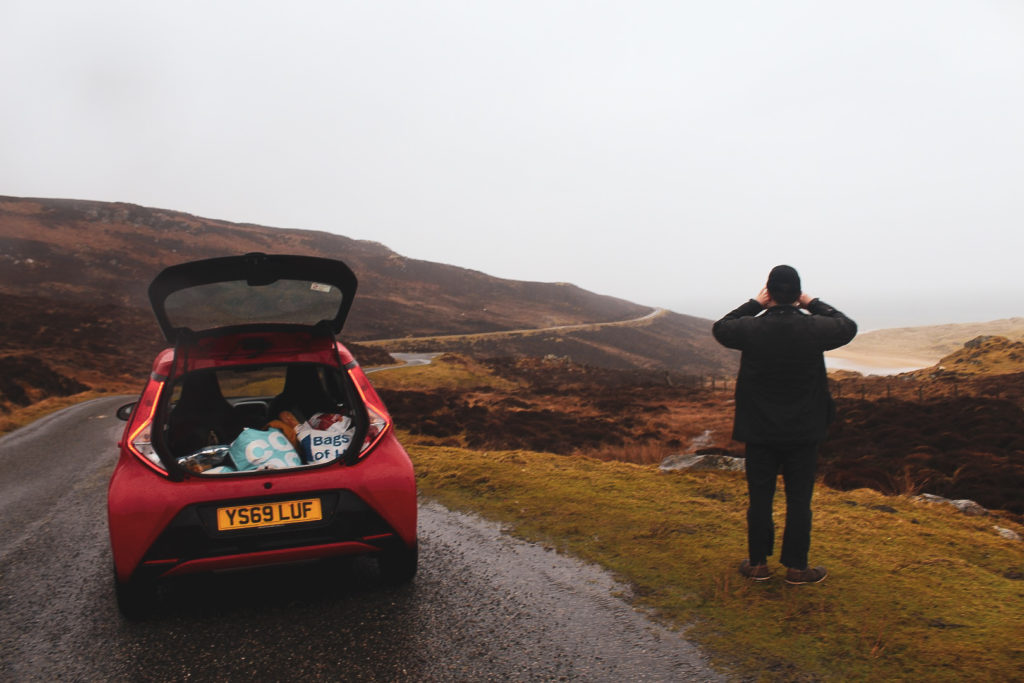

A trip down south – and then back to Lewis and Harris
The next morning, we left Lewis and Harris behind as we caught a ferry south to the Uists and later Barra, but we returned to Lewis and Harris four days later.
We had originally planned to have two full days on the island, but due to a storm and ferry cancellations, we didn’t arrive until 4 PM on the first of the two days. It meant that we had to cut our itinerary short, and we decided to miss out on the Isle of Scalpay, which is connected to Harris by a bridge.
Instead of sailing just an hour from Berneray to Leverburgh, we had to sail back to Skye and then to Tarbert, a trip of over four hours! But at least the ferry ride was incredibly beautiful this time around. The ocean was rough, but the weather was gorgeous and the visibility amazing. Arriving in Tarbert, we paid a short visit to the Isle of Harris Distillery and a gift shop with Harris Tweed items, before hitting the road to make the most of the last few daylight hours.
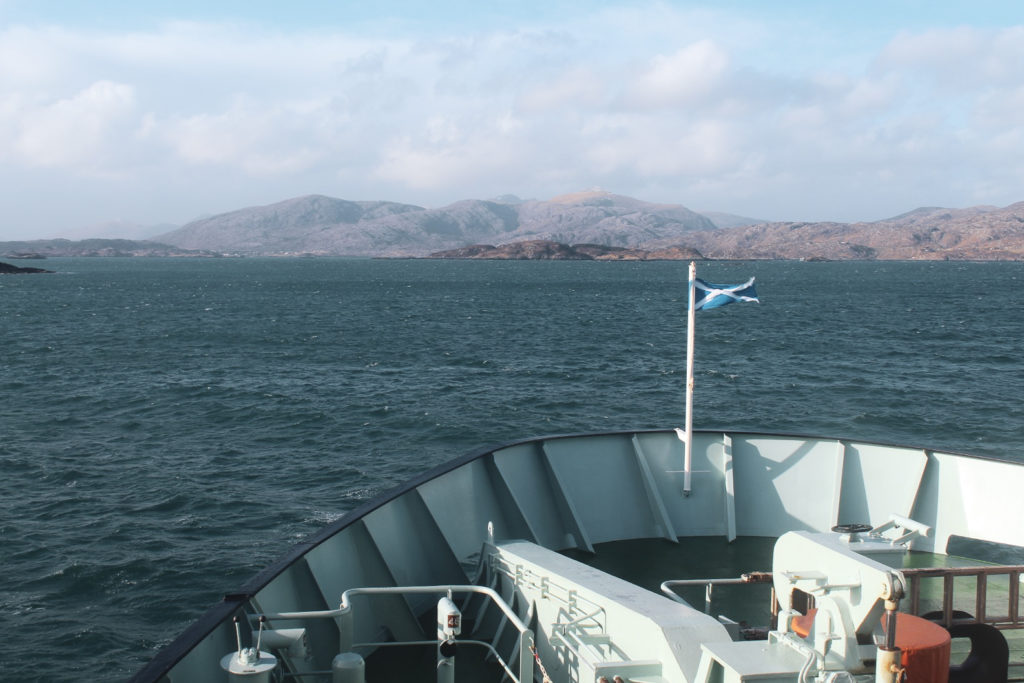
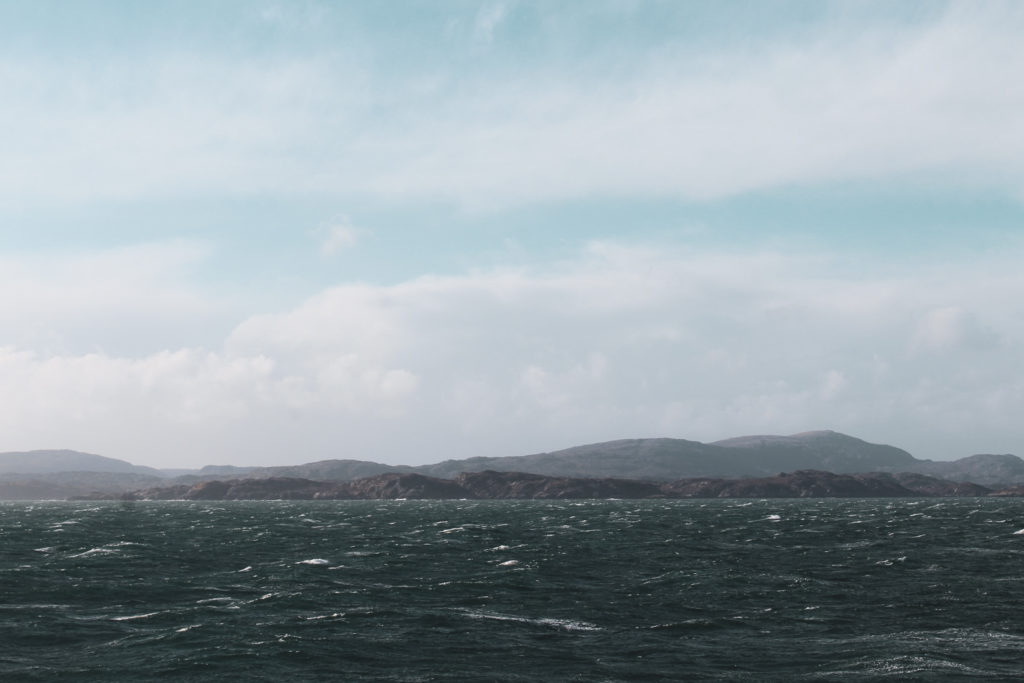
Luskentyre, the most beautiful beach on Harris?
We chose to spend those few daylight hours exploring the southern part of Harris, to then dedicate the full day to Lewis where we had many must-see sights on our wishlist. Harris is incredibly beautiful to drive through, with high mountains and endless sandy beaches. The most popular beach, Luskentyre, was our first stop. It’s often described as a “paradise” or like something out of the Caribbeans, but to be honest, Luskentyre just didn’t live up to my expectations.
It was nothing like the images I’d seen, but I’m sure the weather also played a role as it was grey and windy. The tide was also quite high, so most of the beach had disappeared beneath the ocean. When we passed by again two hours later, the water was right up to the road, leaving no famous beach to be seen.
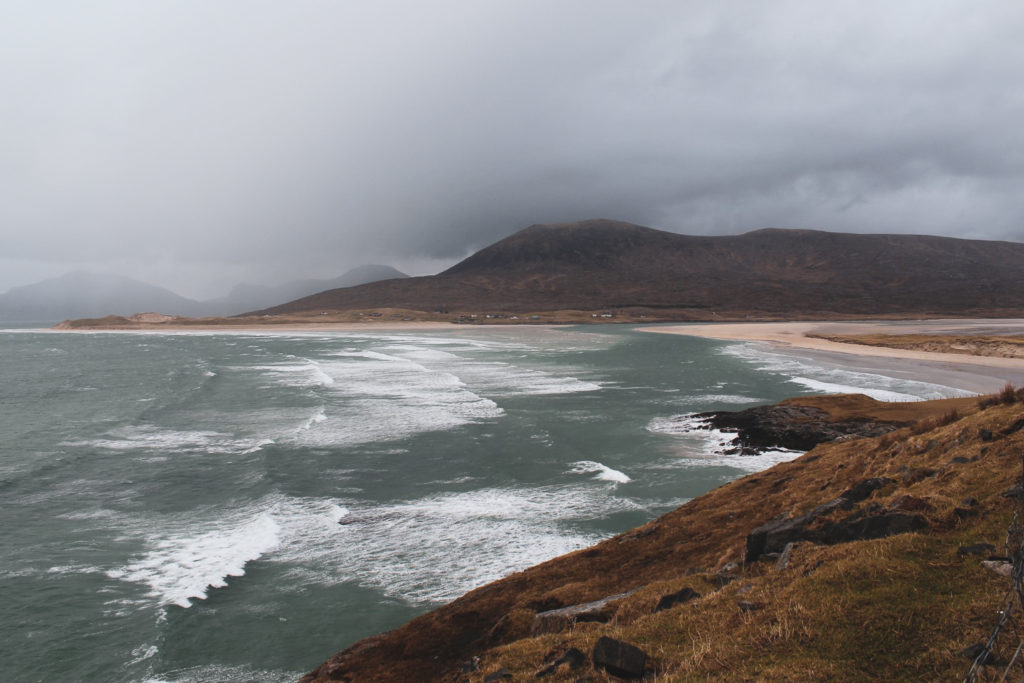
Finding paradise at Scarista Beach
As we drove further south, we came past many beautiful beaches and decided to have a closer look at Scarista Beach, a long stretch of golden sands with low dunes that would give any Caribbean beach a run for its money (unlike Luskentyre).
We parked the car at the side of the road and tried to find our way down to the beach, but it proved more difficult than it probably should’ve been. We had to climb over a few fences and walk through a river before reaching the beautiful golden beach. Finally, we could understand what all the fuss about the beaches of Harris was all about!


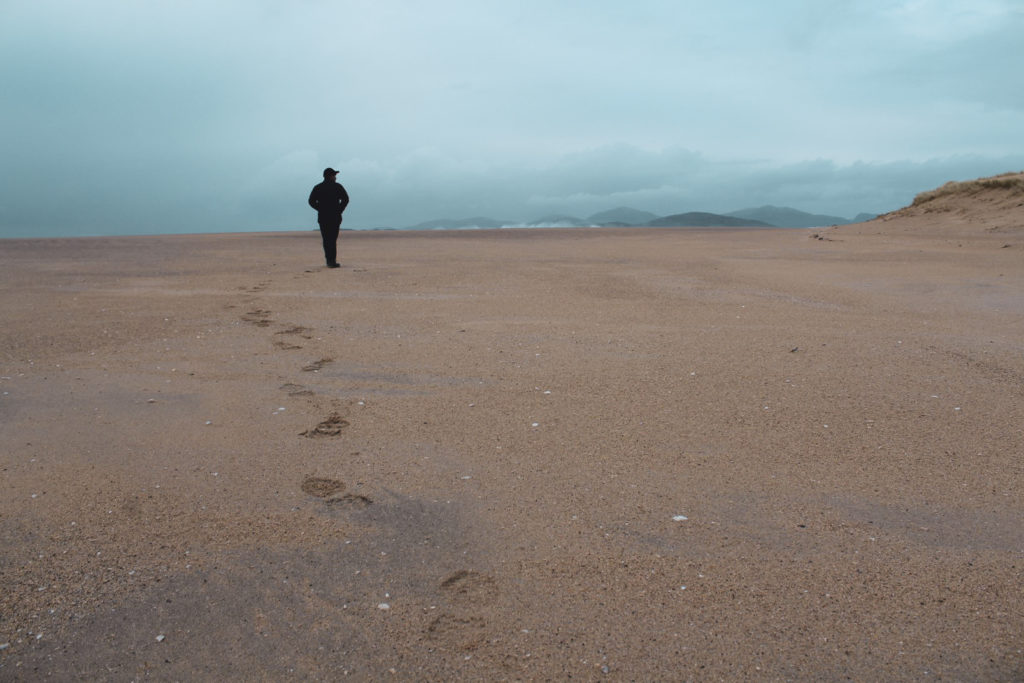
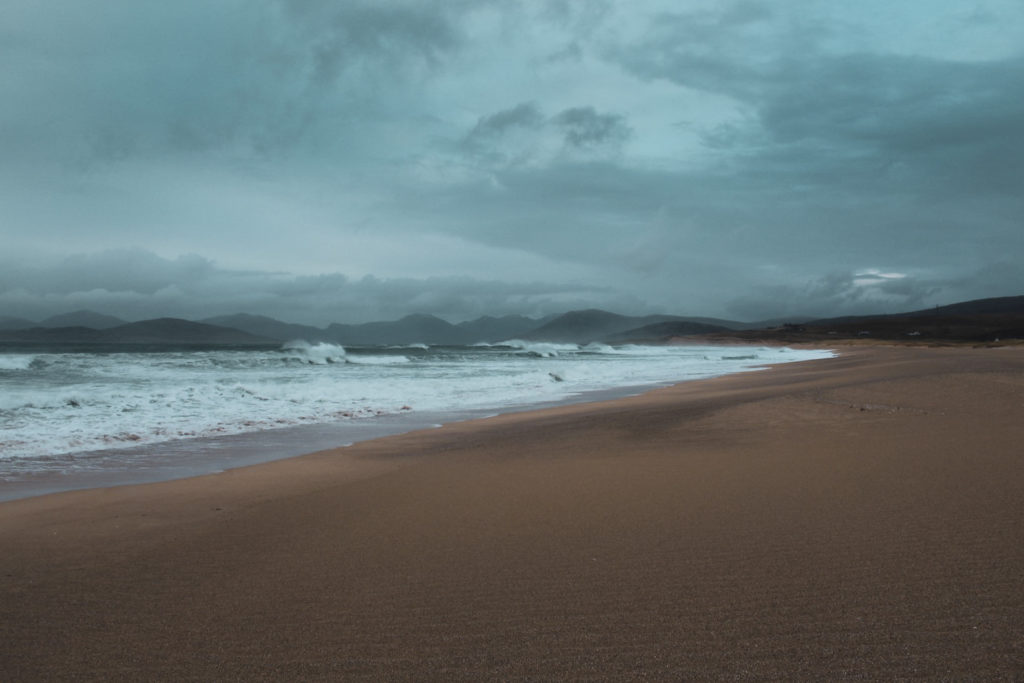
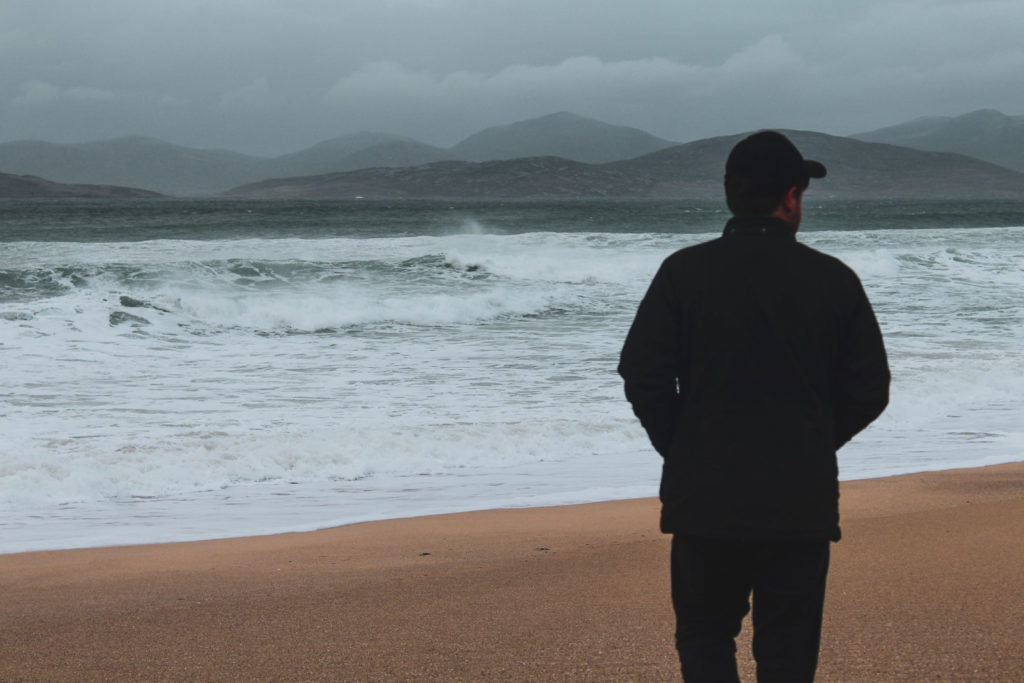
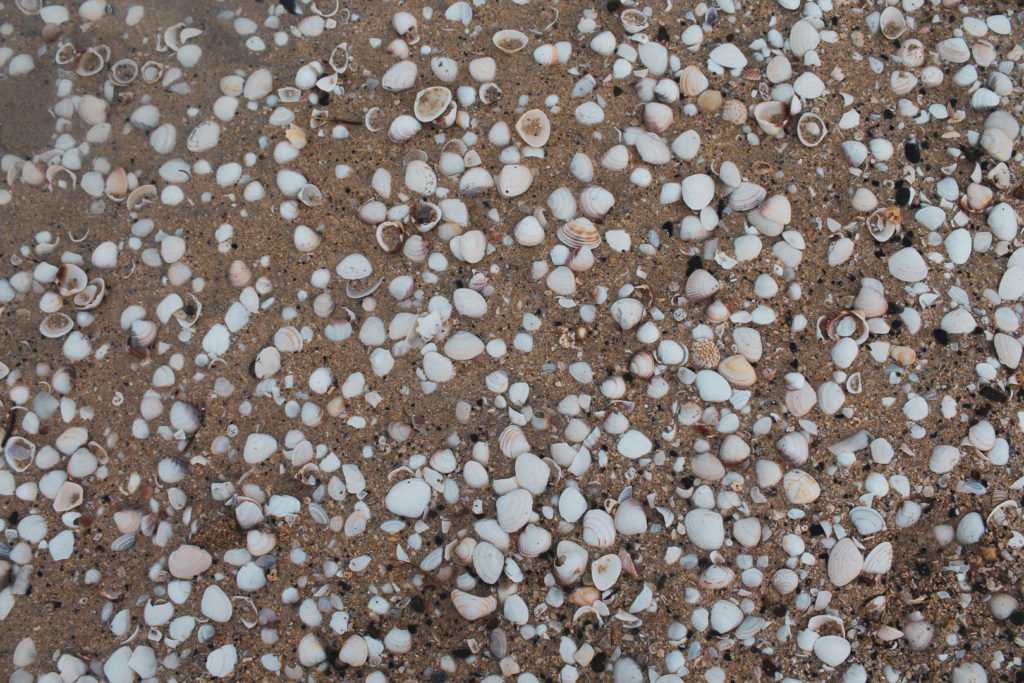
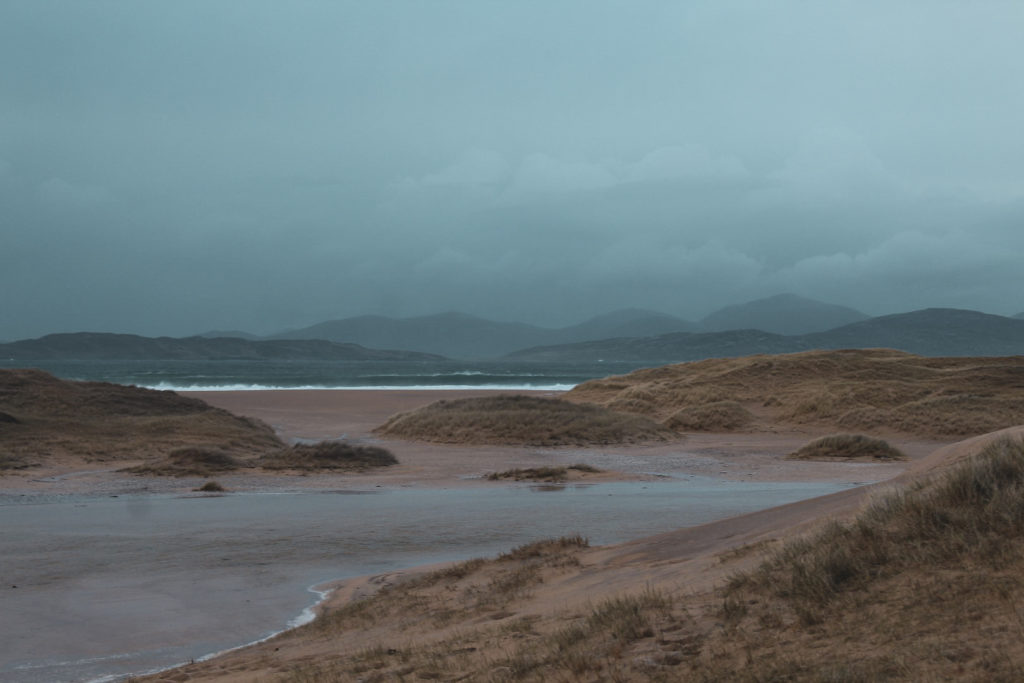
St. Clement’s Church, a medieval wonder at the southern edge of Harris
We continued further south, past Leverburgh where we should’ve arrived with the ferry in the morning, and to the village of Rodel. There, we found St. Clement’s Church, possibly the most impressive medieval building in this part of Scotland, built in 1520 on the site of an older church.
The church looks beautifully out of place in the barren landscapes of the southern edge of Harris, but it was of central importance for the local Clan MacLeod. Many of their clan members were still buried in the churchyard even after the church fell out of use following the Reformation in 1560. It even houses the tomb of the church founder, Alexander MacLeod.
We tried the door, and to our great surprise, it was open and there were no one else in sight, so we could explore freely for as long as we wanted. We explored every room and walked up every staircase, and spent ages reading all the signs with information about the church and the Clan MacLeod. And we both agreed that St. Clement’s – unexpectedly – was one of the most interesting churches we’d ever visited!
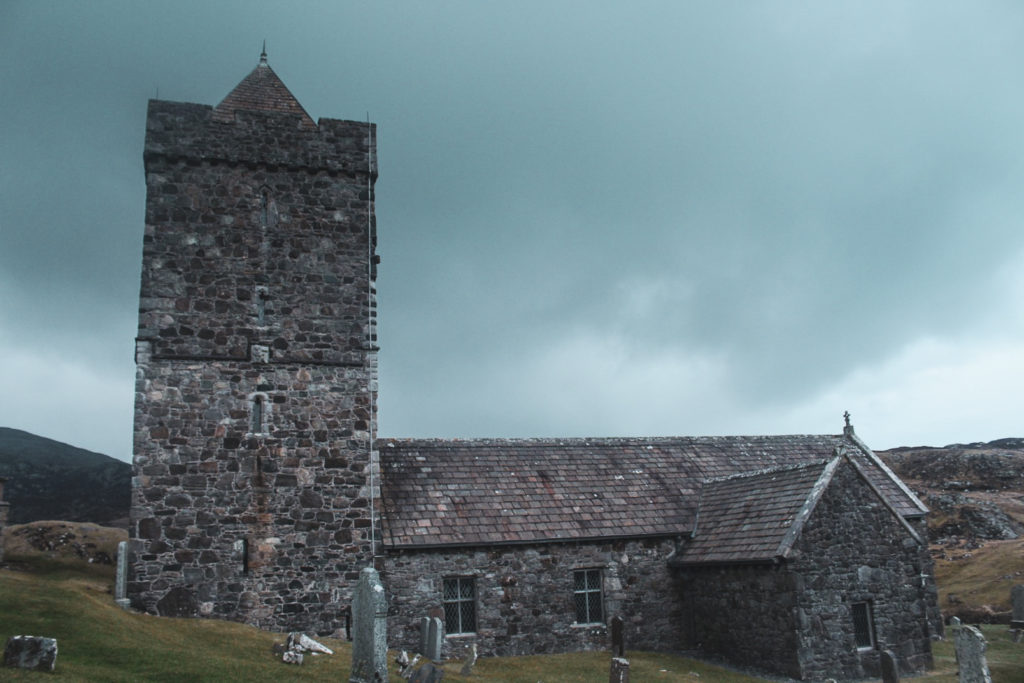
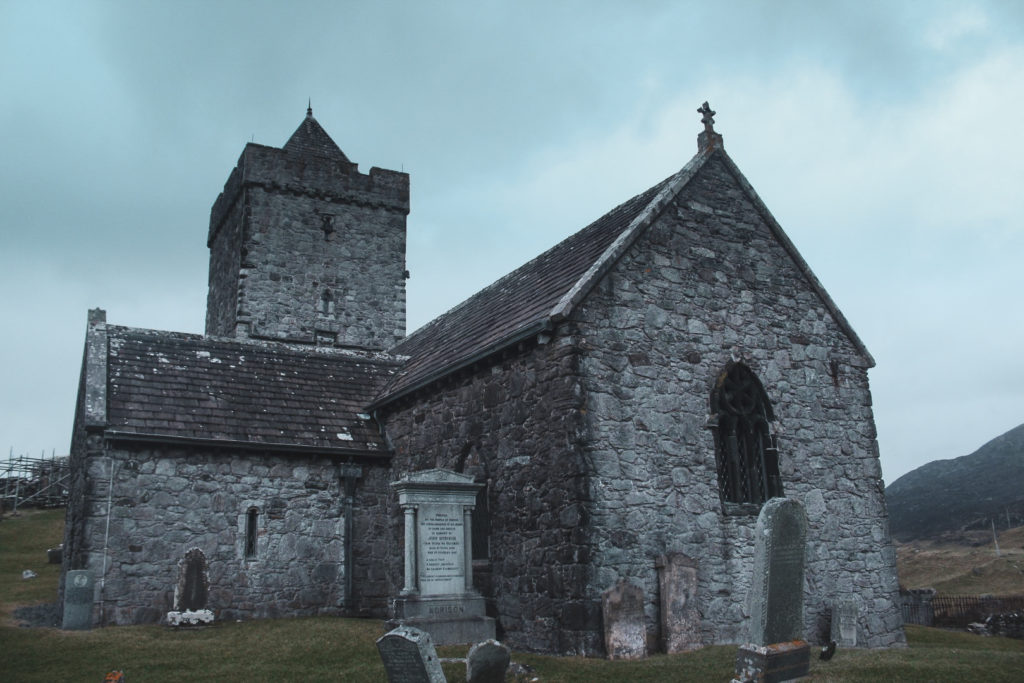
Searching for a cave at nightfall
The sun had set when we walked out of the church door, but our explorations would not end there. Brandon had spotted a nearby cave opening on the map, and we decided to try to locate it, darkness or not.
Located about 300 meters from the road, the cave was not easy to find, especially since it only got darker and darker, but we think we found it in the end. We couldn’t actually see the entrance to the cave as it faced the ocean, but the views of the coastal cliffs were incredible – even in dim light.

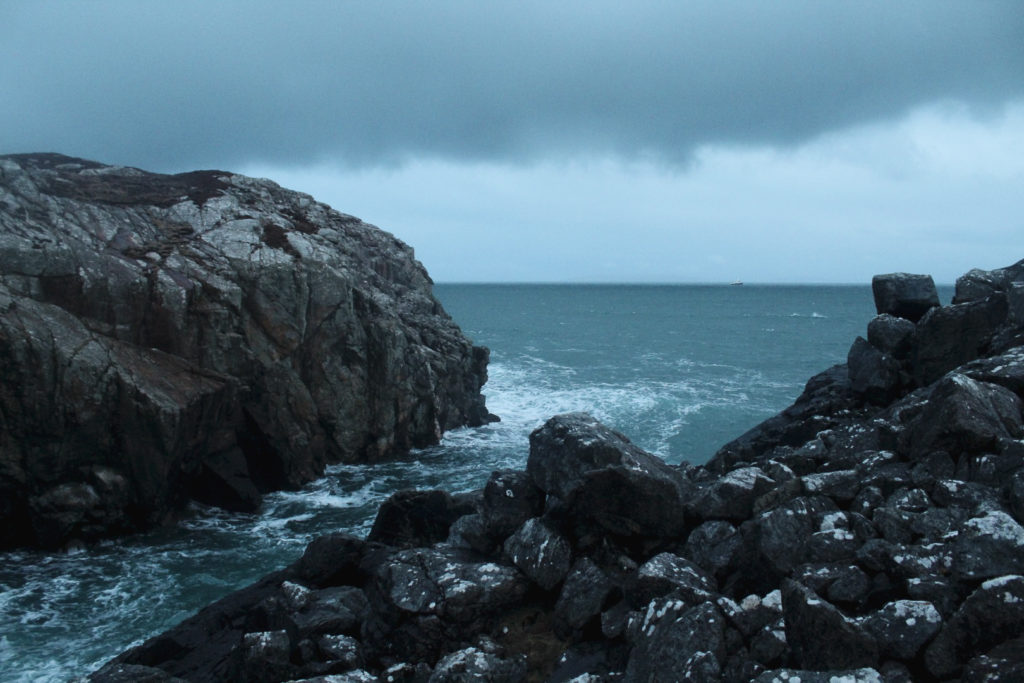
To the Butt of Lewis
With 59 miles to Stornoway where we had an airbnb for the next two nights, we had lots of driving in the dark ahead of us. We were hit by a snowstorm as we drove through the mountains of Harris. It was difficult to see anything so I drove really slowly and it took forever before we finally reached the flat moorlands of Lewis. The change in landscapes was incredibly obvious. After a while of driving on flat roads, we arrived in Stornoway. We soon found our cozy airbnb and I settled in for the night while Brandon went into town to meet with our former colleague, James.
The next morning, we woke up early to be on the road by 7 AM. We had to return the car by 3 PM and we still had just about everything to explore on Lewis – and on Lewis, everything is A LOT! Luckily, the weather was amazing, the best it had been on our entire trip.
We picked up James on the way, and then the three of us headed to the very north of the island, to the Butt of Lewis Lighthouse from 1862. The sun had only just risen when we arrived, so the light was soft with beautiful pastel colours in the sky. I wasn’t sure what to expect on this first stop, but it blew me away. Butt of Lewis is not “just” a lighthouse, it’s an incredible location with rocky coastal cliffs and endless ocean views. And standing on the northernmost point of the Outer Hebrides was pretty cool too! In five days, we’d driven to the very south of the Outer Hebrides and back, and now we were at the northern end of the island chain.

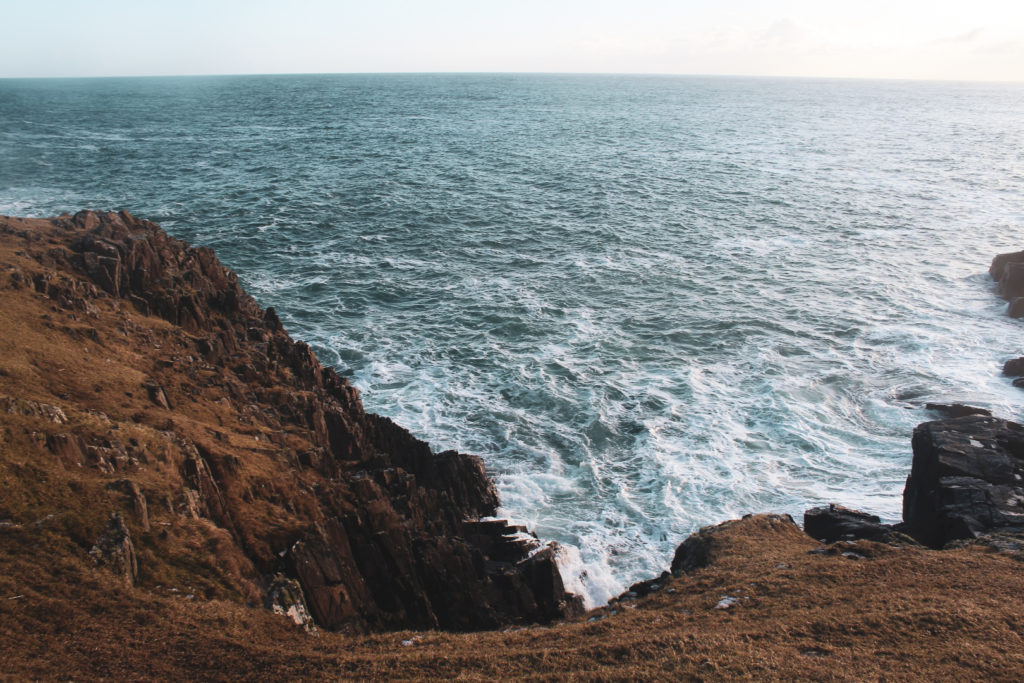
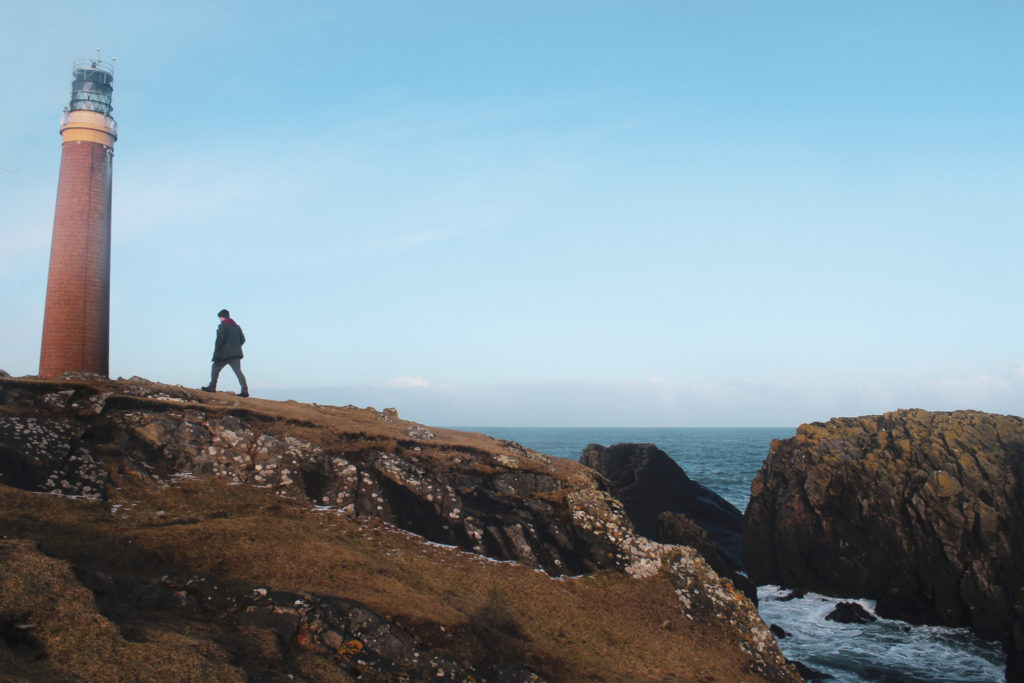
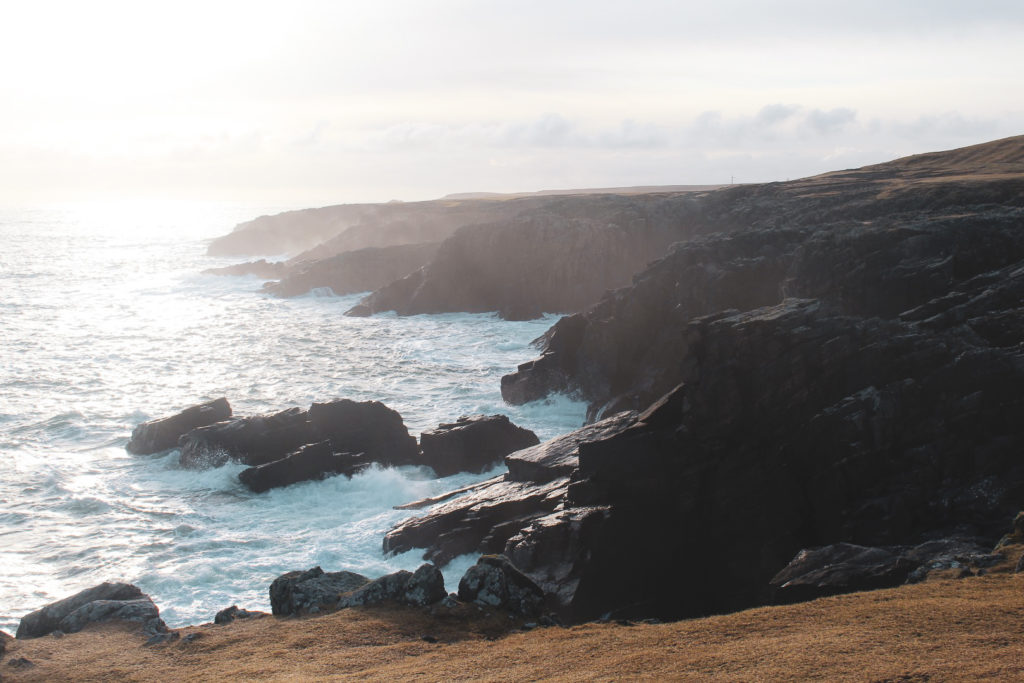
The historic blackhouses of Lewis and Harris
Blackhouses are a traditional type of house consisting of stone walls with the gaps filled with earth or peat and a thatched or turf roof. The house type is found in Ireland, the Scottish Highlands and both the Inner and Outer Hebrides, and its design dates back several thousand years. While the houses aren’t actually black, they were called so to distinguish them from the newer ‘white houses’ from the late 19th century that – unlike the blackhouses – were designed to separate humans from their livestock.
On Lewis, this house type was still being built as late as the mid-19th century, and some blackhouses were still inhabited until the mid-1970’s! Today, many of them still stand, and we set out on a mission to explore some of them. Our first stop was Arnol, a tiny village which is home to a small blackhouse museum, consisting of a fully furnished thatched blackhouse and a ruin of a blackhouse, amongst some of the ‘white houses’ that replaced them.
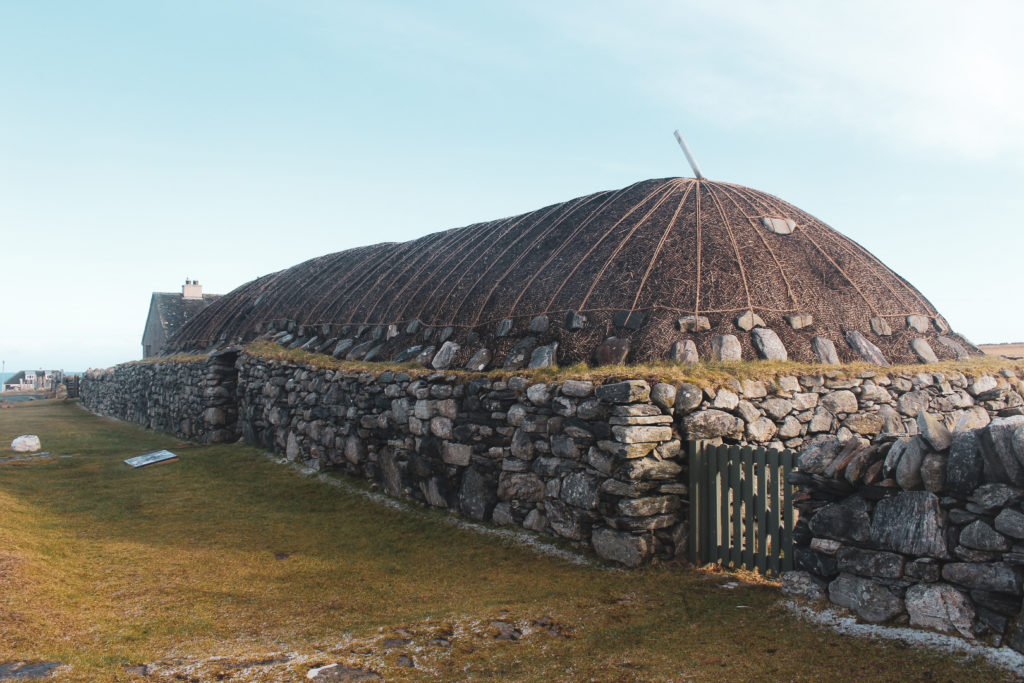
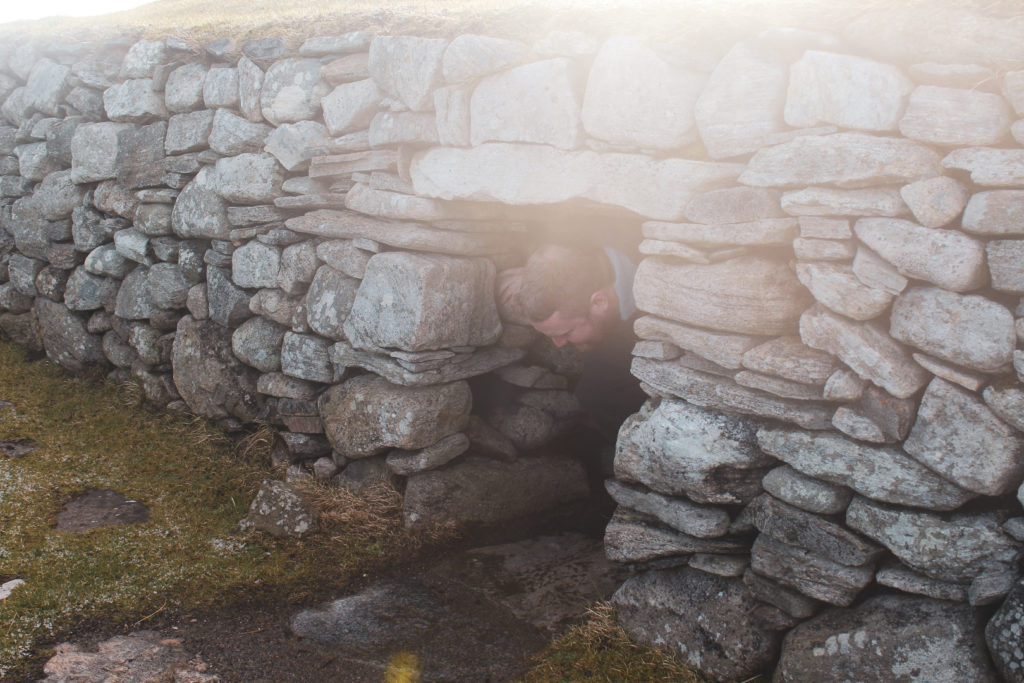
To the Iron Age at the Shawbost Mill and Kiln
We left the 19th century for a while and travelled a thousand years back to the Iron Age. We parked at a small car park, and made our way down a scenic path to a gorgeous location by a calm river. There sits a reconstruction of an Iron Age corn mill and kiln for drying grain, the Shawbost Mill and Kiln, built as traditional blackhouses. Lewis was once home to around 200 of these types of mills, and this one remained active as late as the 1930s.
I really enjoyed this area and would’ve loved to experience it as an open air museum with reenactors. I think it has the perfect setting for that kind of experience!


A blackhouse village
Further south, we jumped in the time machine again and ended up in the late 19th century at the once-abandoned but now thriving Gearrannan Blackhouse Village. The village is now a museum and a café, and it’s even possible to stay the night!
If you only have time to visit one blackhouse location, choose this one as you get a range of different houses all in one place!
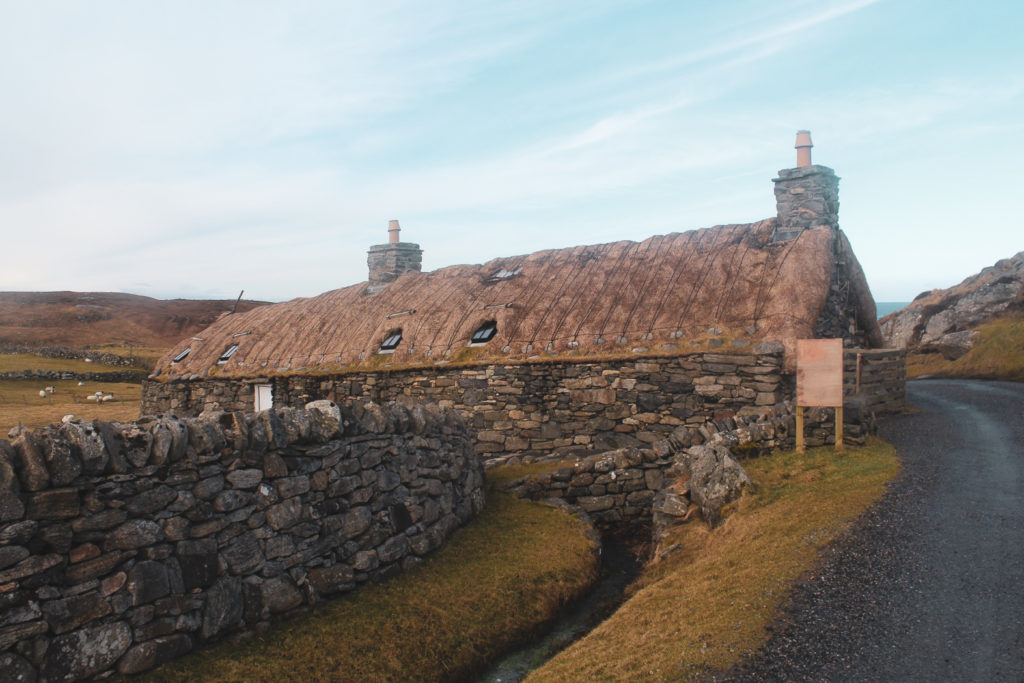
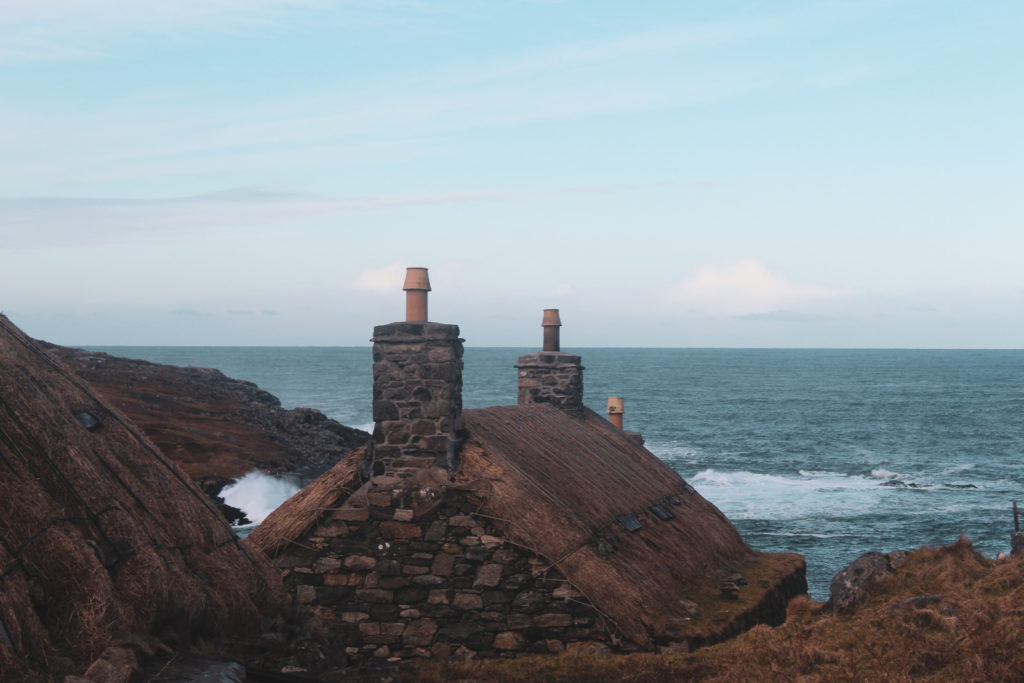
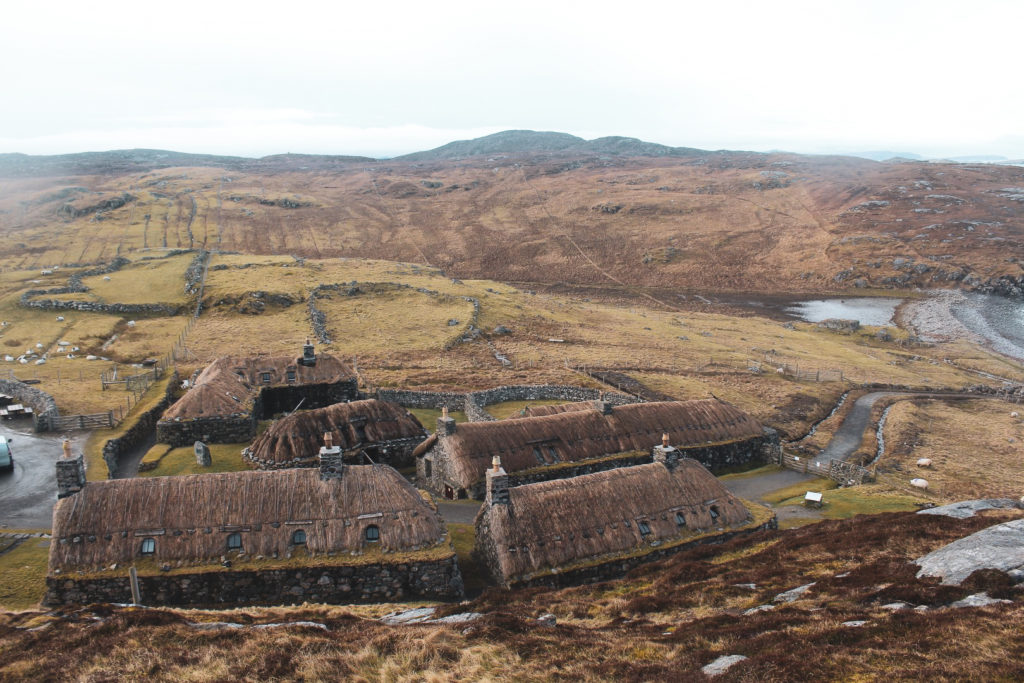
Back to the Iron Age at Dun Carloway
We headed back in time to the Iron Age once again, to visit a broch, a type of roundhouse found all over Scotland. This particular one was built in the 1st century AD on top of a hill, and up until the 16th century, the walls were still mostly intact. Unfortunately, many of the stones were re-used in other buildings in later centuries, but the east side of the old wall still reaches to 9 metres tall.
When we were there, it was under restoration so we couldn’t explore its interior, but the well-preserved exterior was impressive nonetheless.
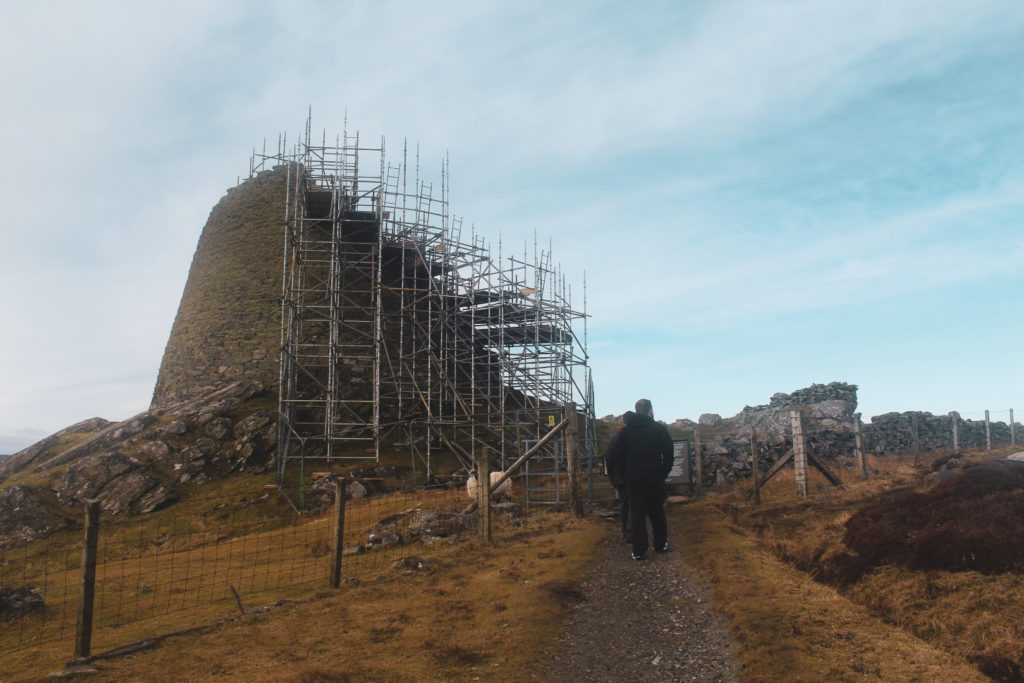
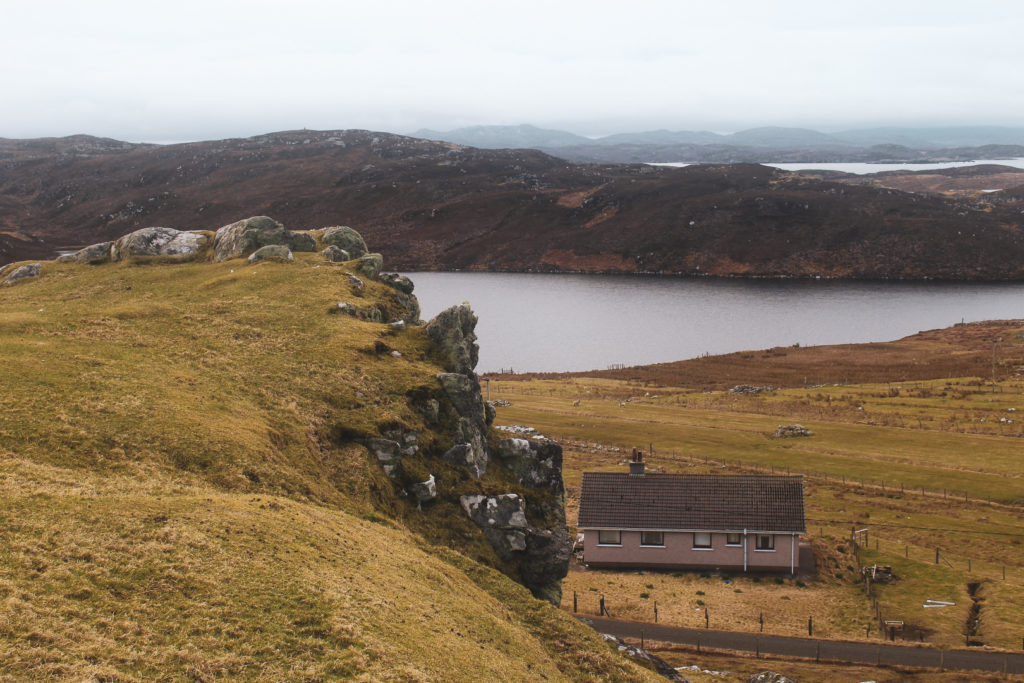
To the Stone Age at the Calanais Standing Stones
And finally, we arrived at the destination I’d been most excited for on the entire trip – the Stonehenge of the Outer Hebrides, the Calanais Standing Stones (or Calanais I)! But hold your breath, history lovers, because this one is actually 500 years older than its (much) more famous cousin, Stonehenge!
Erected in the late Neolithic between 2900 and 2600 BC for an unknown purpose, and used for ritual activities during the Bronze Age, walking amongst this ancient stone circle was like taking a step back into prehistory. I could imagine the events that took place there, and the impressive sight that guests were met with as they approached the structure. There were no tourists on the site apart from us, and we were free to touch (and hug!) the stones – something you’d not experience at the Stonehenge.
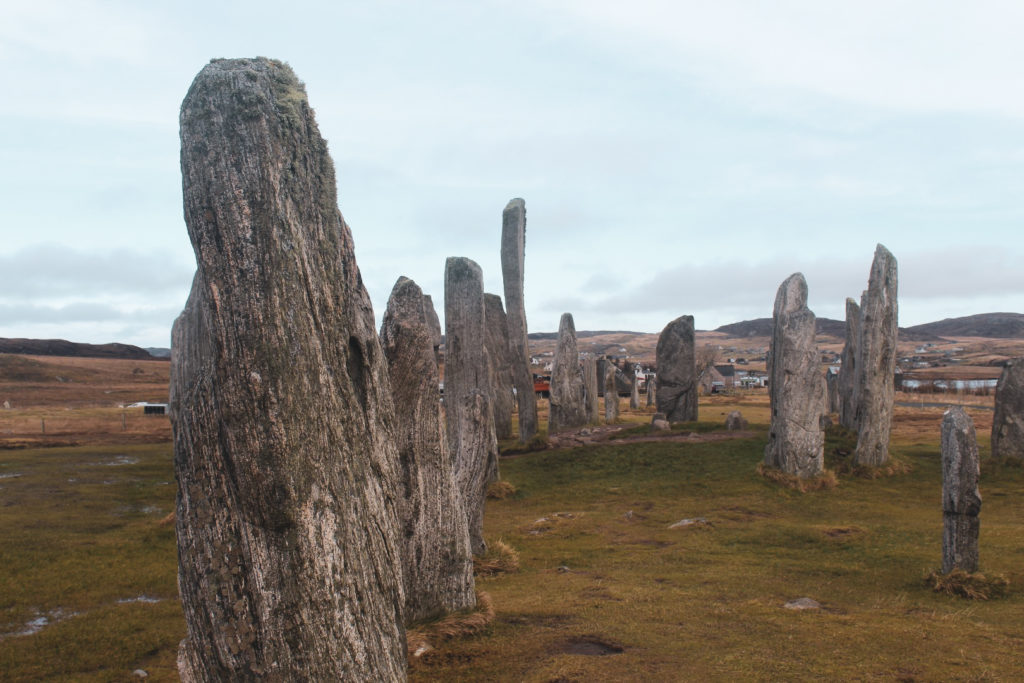
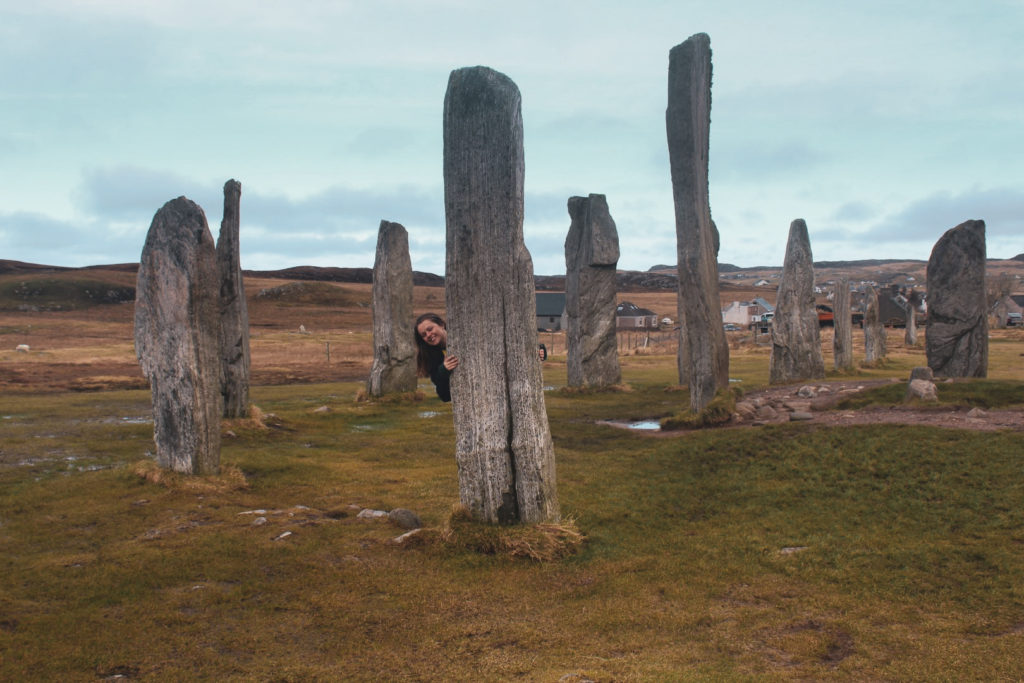
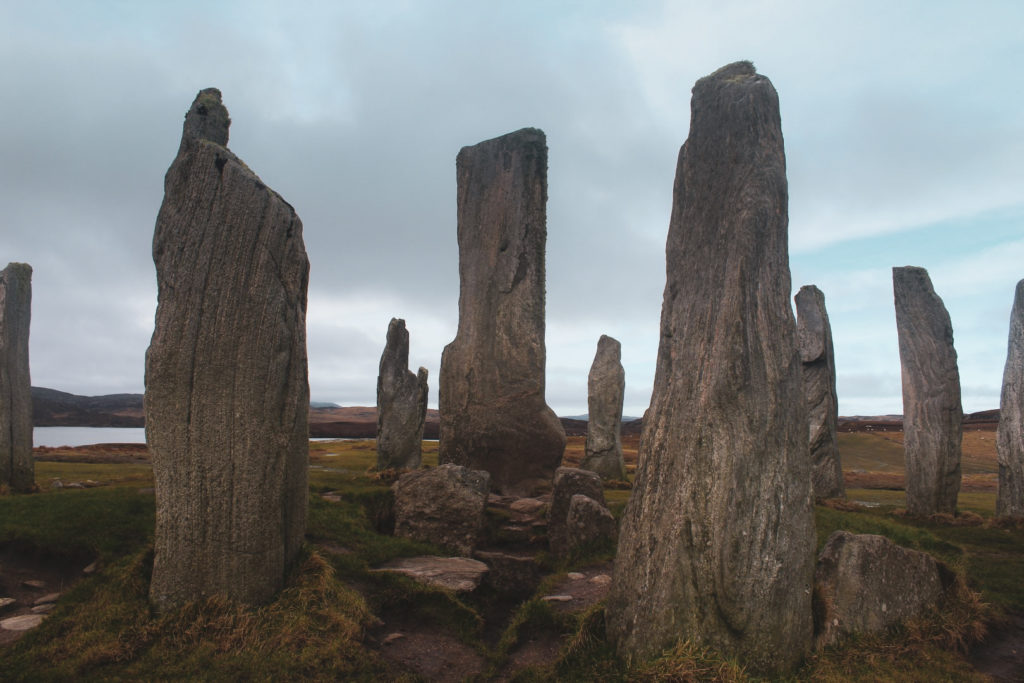
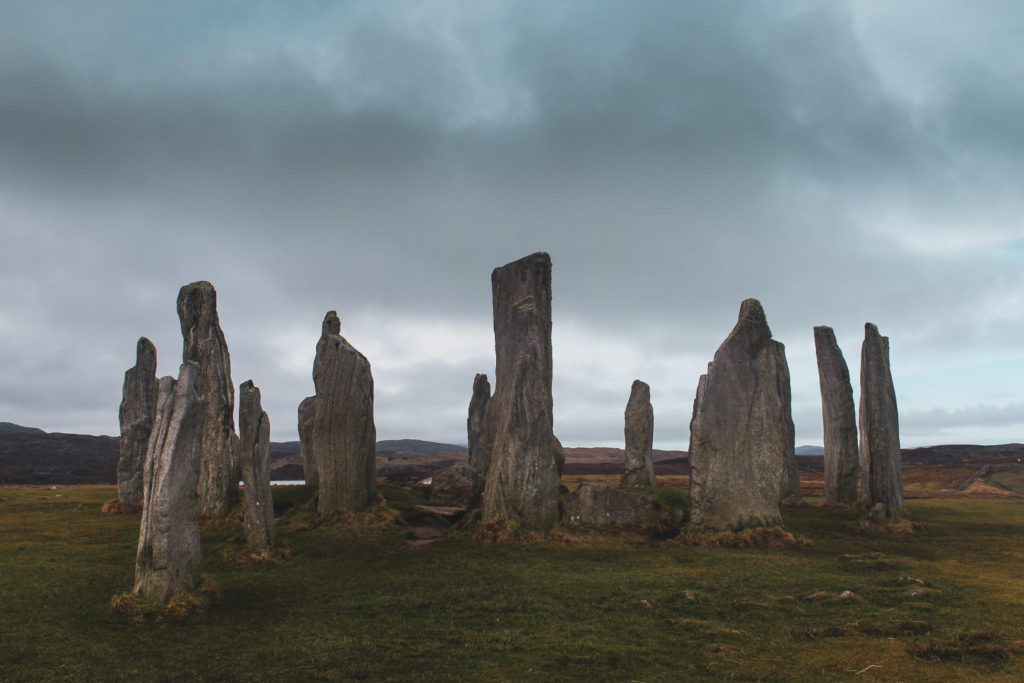
The other stone circles on Lewis
You might be surprised to learn that Lewis and Harris, much like Orkney, also has a Neolithic stone circle, but the island doesn’t just have one, it actually has several less prominent stone circles as well as single standing stones, numbered as Calanais II to XIX!
We didn’t even know this beforehand, but we spotted many of them as we drove along the road! We found that Calanais II and III were almost as impressive as Calanais I, and we were grateful to be able to explore them as well, so we could take in the whole Neolithic experience of Lewis and Harris!

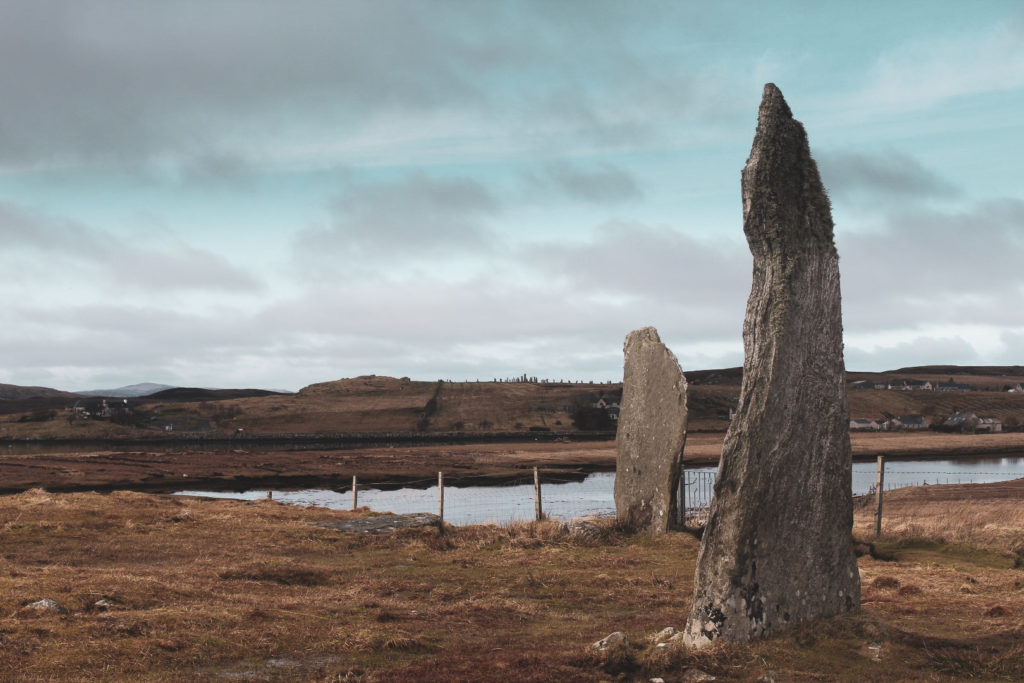

The enchanting beaches of Lewis
While I stated earlier that Lewis consists mostly of flat moorlands, there is a hilly and rugged area at the southwestern part. This area of the island is so incredibly beautiful, and actually turned out to be my favourite place in the Outer Hebrides.
The white sands of Cliff Beach came into view, beckoning us to stop for a breather. Continuing along, we soon reached the even more gorgeous Reef Beach, and decided to take a walk along its soft sandy stretches while the sun rays kept our faces warm.
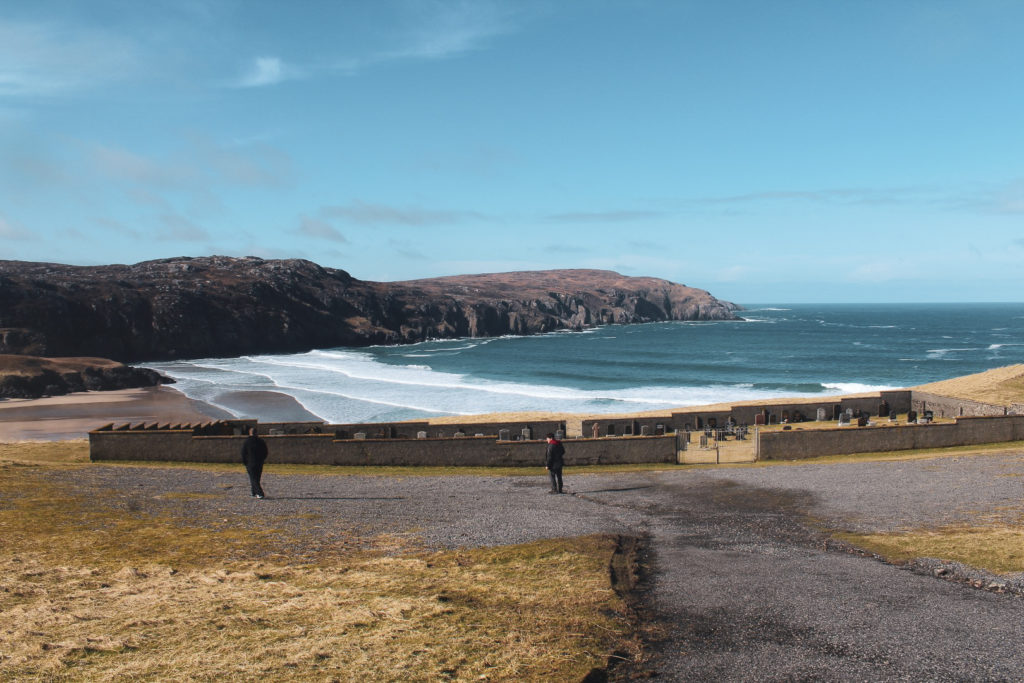


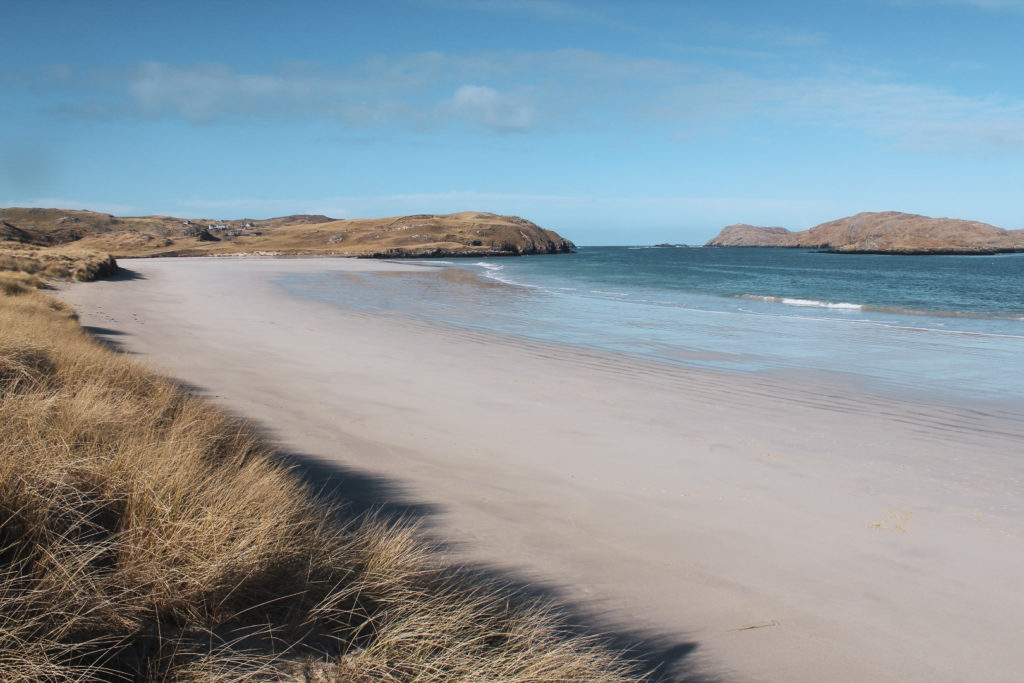
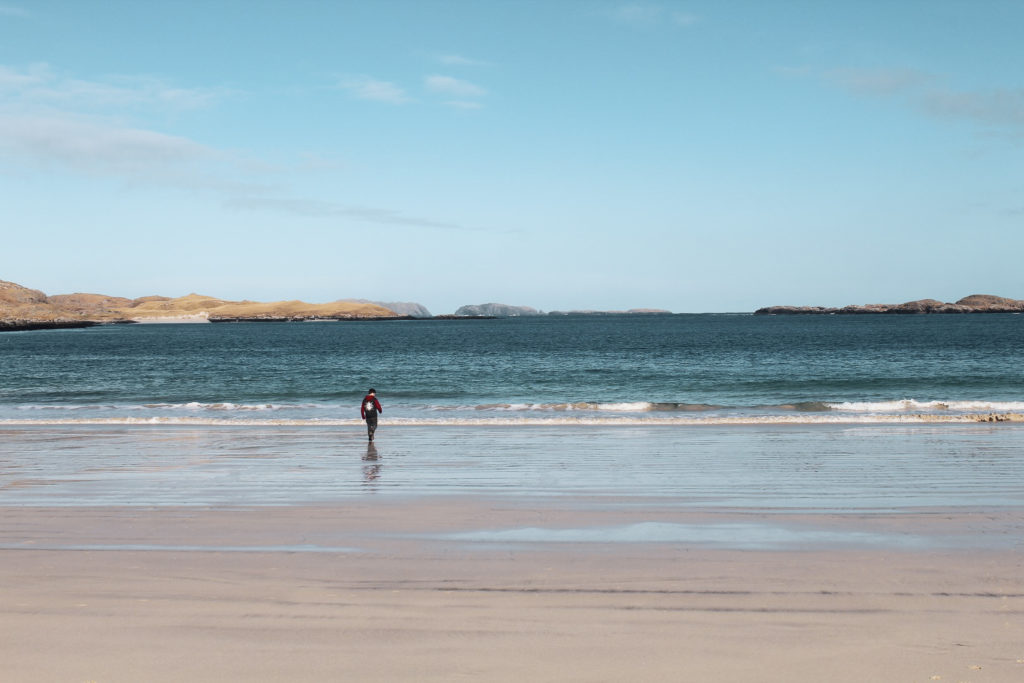
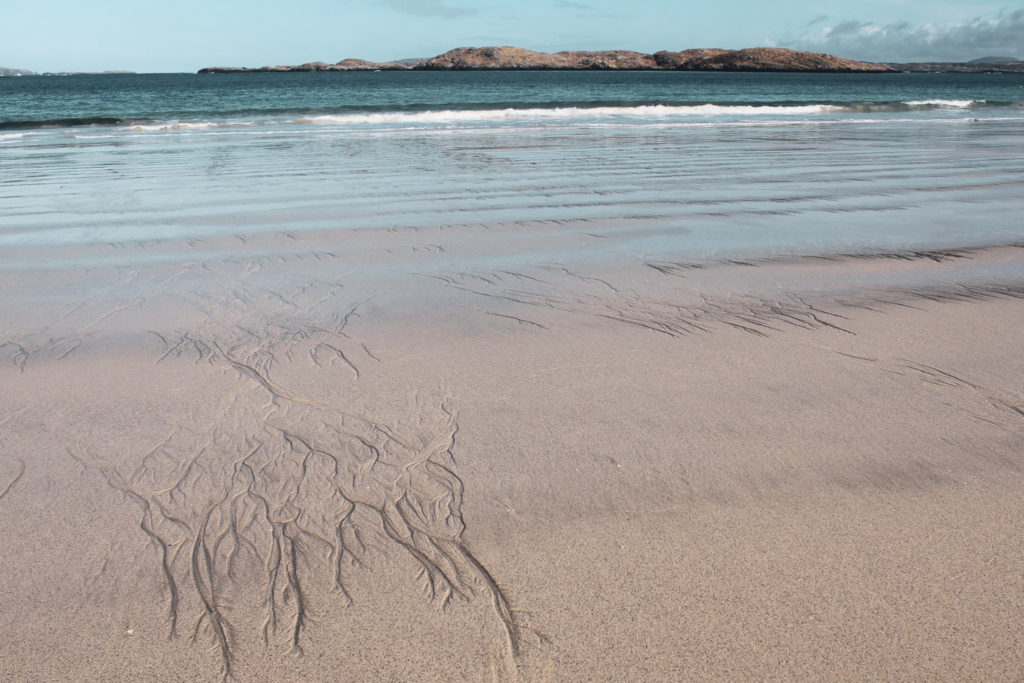

Finding the Lewis Chessmen
The sands of Lewis kept a group of unique 12th-century chess figures carved from walrus ivory and whale teeth hidden for hundreds of years until they were discovered in 1831. Although a legend says that a cow unearthed the artifacts, it’s generally thought to be Malcolm MacLeod that discovered them in a small stone kist hidden in a dune. They are thought to belong to some of the few surviving medieval chess sets. 82 pieces can be seen at the British Museum in London, while the remaining 11 pieces are exhibited at the National Museum of Scotland in Edinburgh.
But it’s also possible to learn about the chess figures and their discovery on Lewis. Large versions of them can be found in the area near Mangersta in a few different locations. We actually found them by chance as Brandon was looking at the map and asked me to stop for a sculpture. It turned out to be one of the chess figure statues, and we later discovered two more!
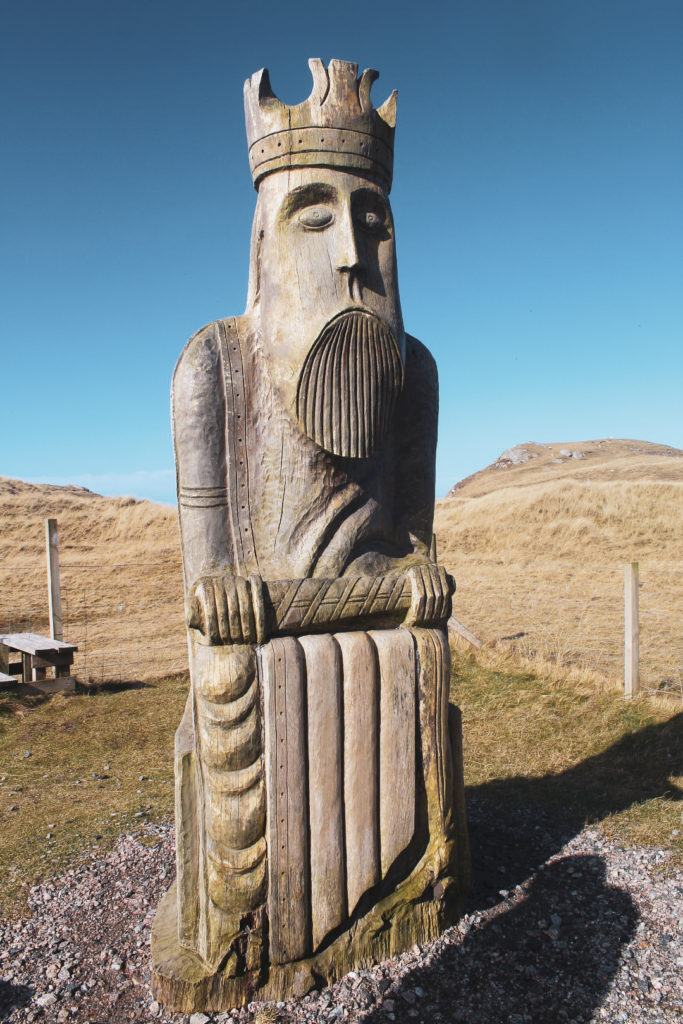
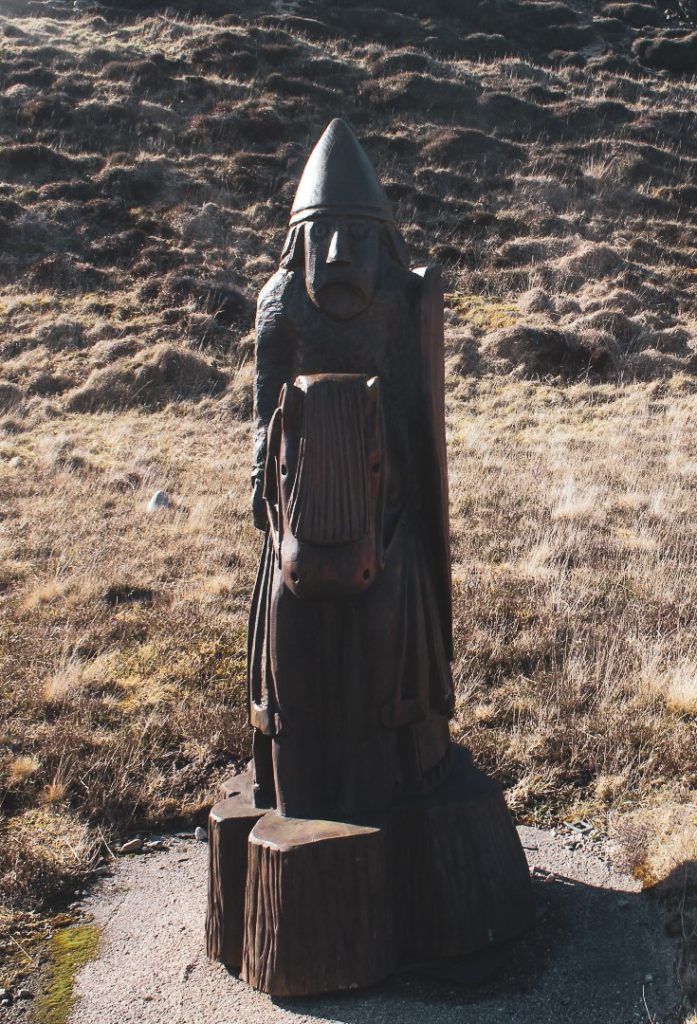
Blown away by the Mangersta Sea Stacks
The last place we visited on our roadtrip through the Outer Hebrides was the most beautful of them all.
We drove to the Mangersta Sea Stacks, expecting to find a beautiful and rugged coastline, but not expecting to be as overwhelmed as we were. Maybe it was the enormous crashing waves, maybe it was the many rocky sea stacks, or maybe it was the soft and misty light. No matter what it was, Mangersta blew me away completely.
Unfortunately, we only had half an hour to spare at the sight before having to return to Stornoway to return the car, and it was nowhere near enough time. I ran from cliff edge to cliff edge, capturing the breathtaking views and staring out at the enormous crashing waves, the highest waves I’ve ever seen. I could’ve spent hours there. What an amazing place!
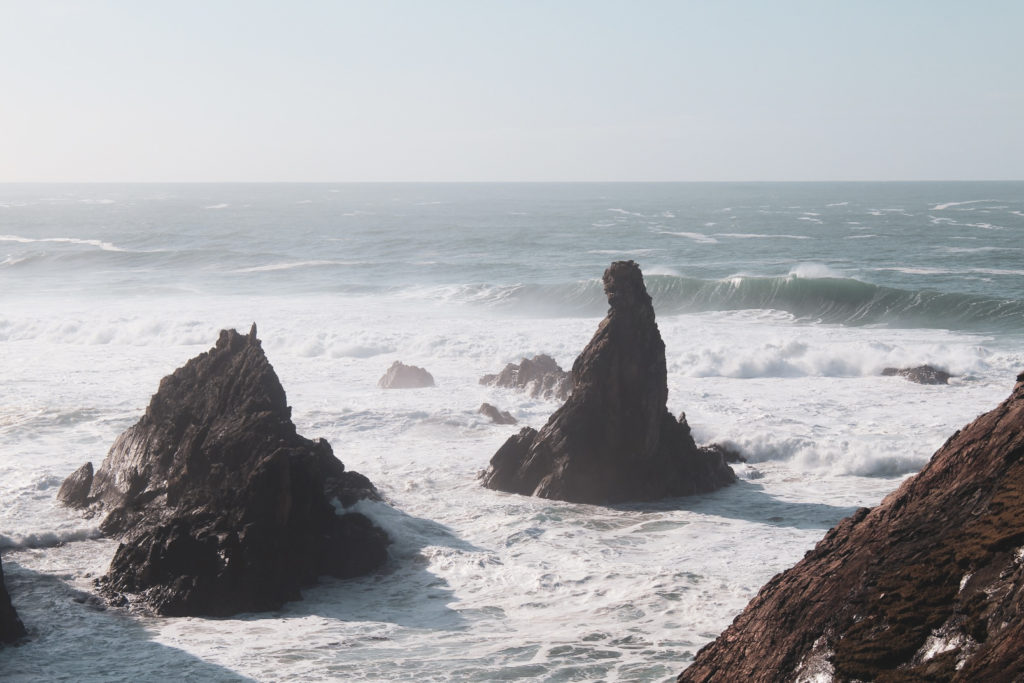

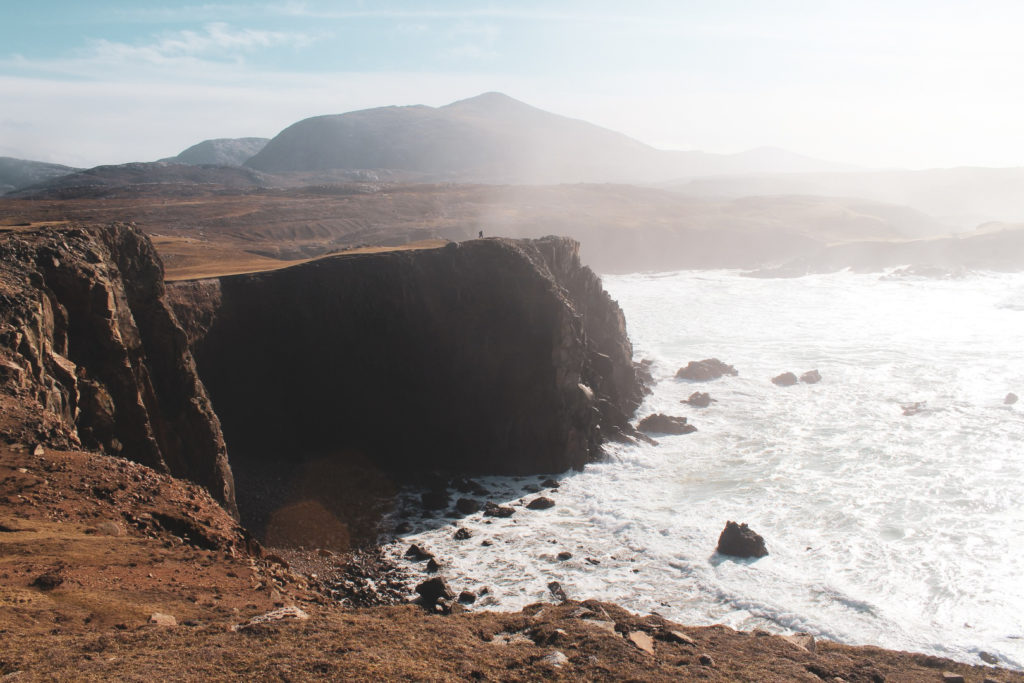
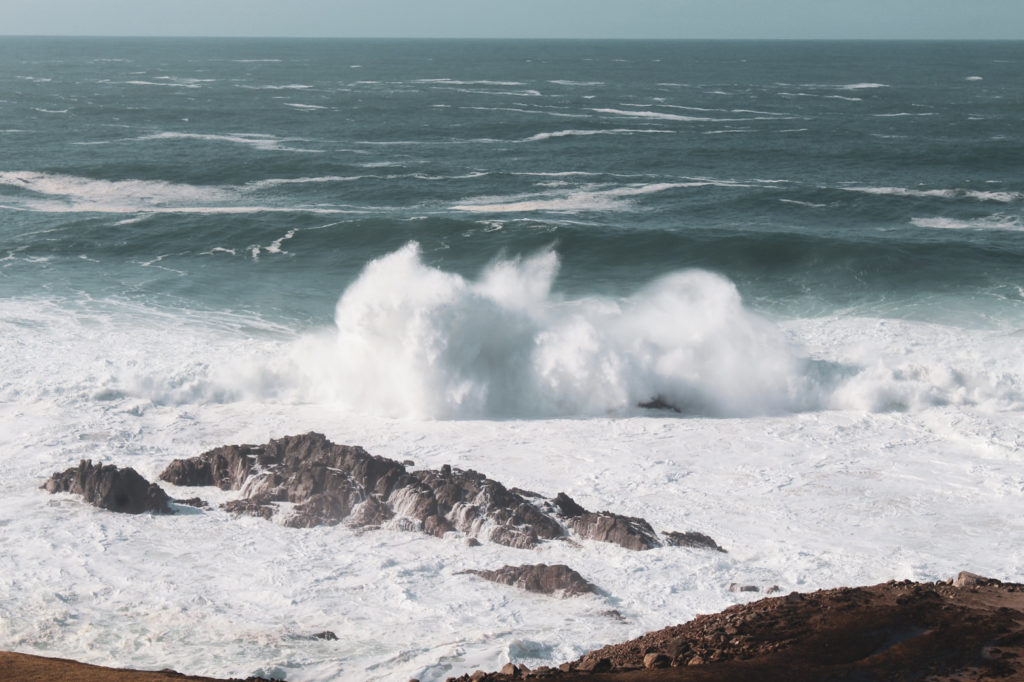
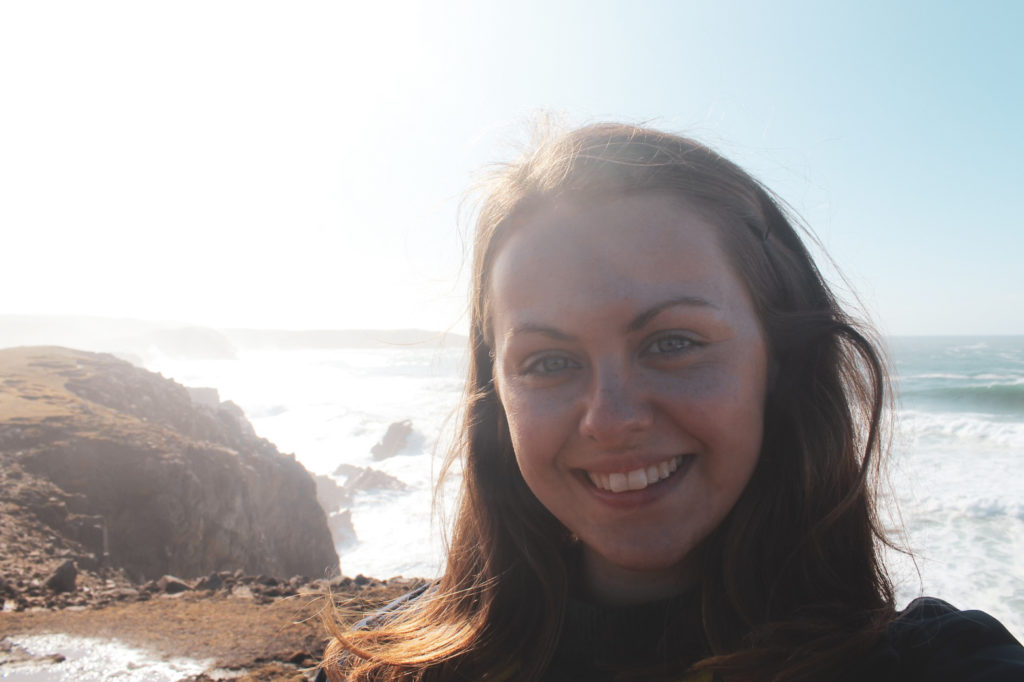

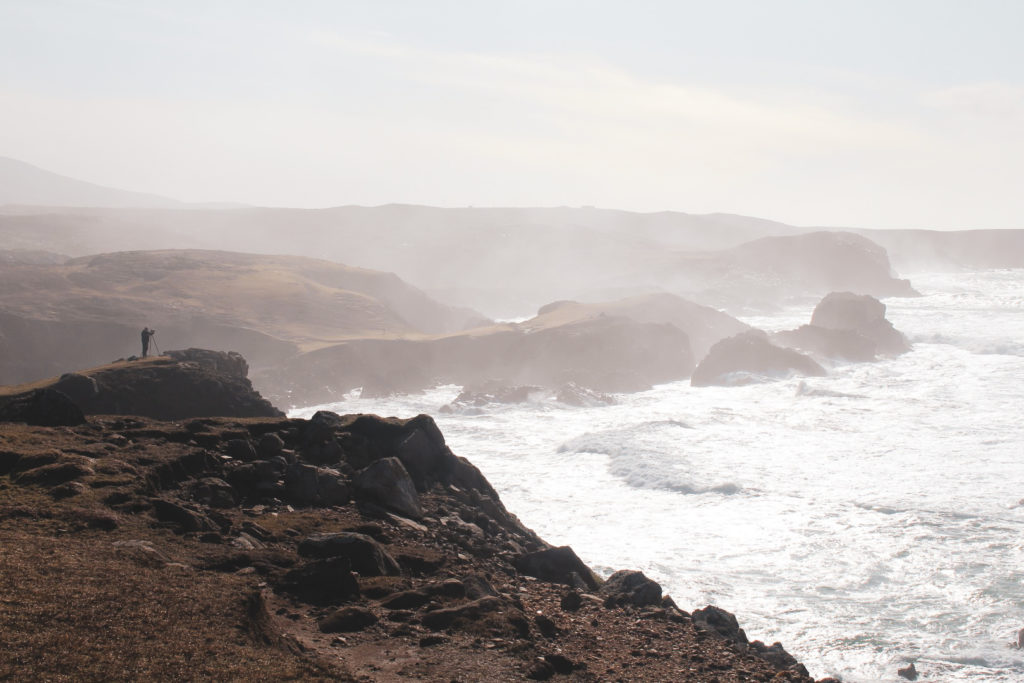
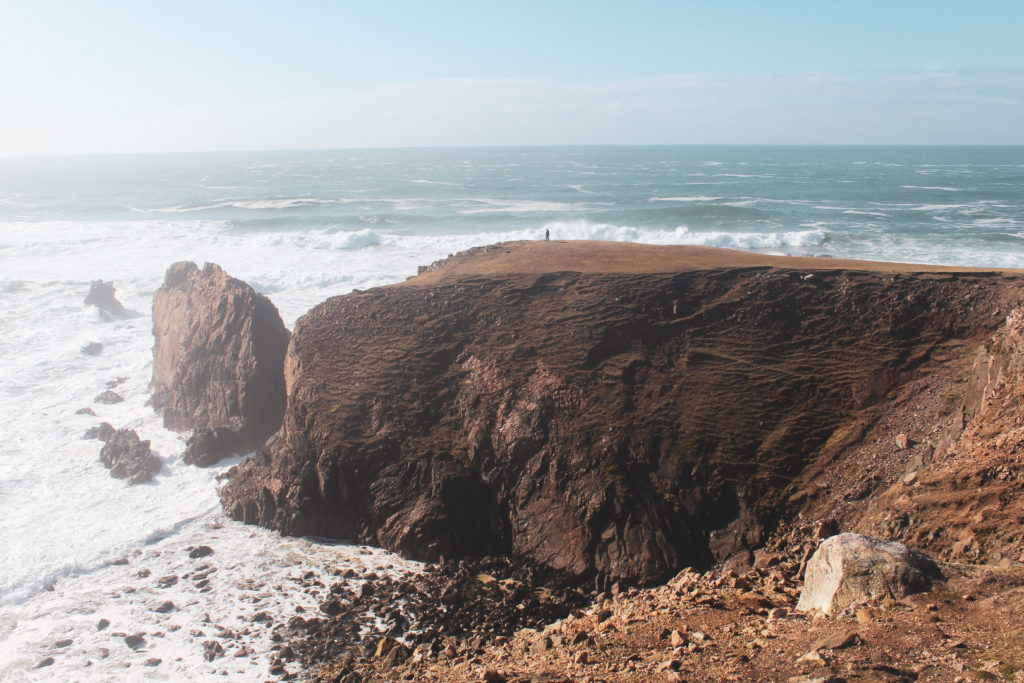

We made our way to Stornoway
So I made my way to Stornoway,
On the road to Orinsay,
Where my thoughts return each day,
My lovely Stornoway.
With the song above playing over and over again in our heads, we arrived back in Stornoway just half an hour before having to return the car, enough time to give it a quick clean and fill it up with petrol. Once we had said goodbye to the car, we walked into the streets of Stornoway to explore the tiny centre of the quaint town, which looks like any other cozy British provincial town.
Lews Castle from the mid-19th century towers above Stornoway and makes the town stand out. We walked up to the castle and found a perfect spot on the grass to enjoy our lunch with a view over the town and its tiny harbour.
The quiet evening hours spent in Stornoway was the perfect way to end our journey through the Outer Hebrides – and our world travels, for now. The next morning, we caught a morning flight back to Denmark, the same day that the country went into the first Covid-19 lockdown.
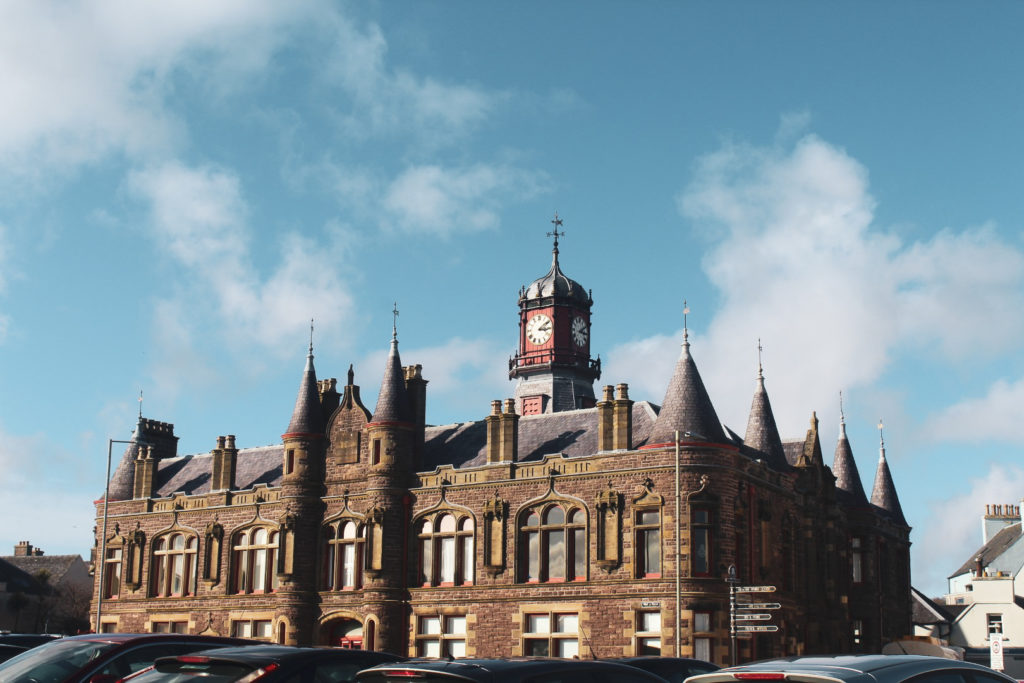


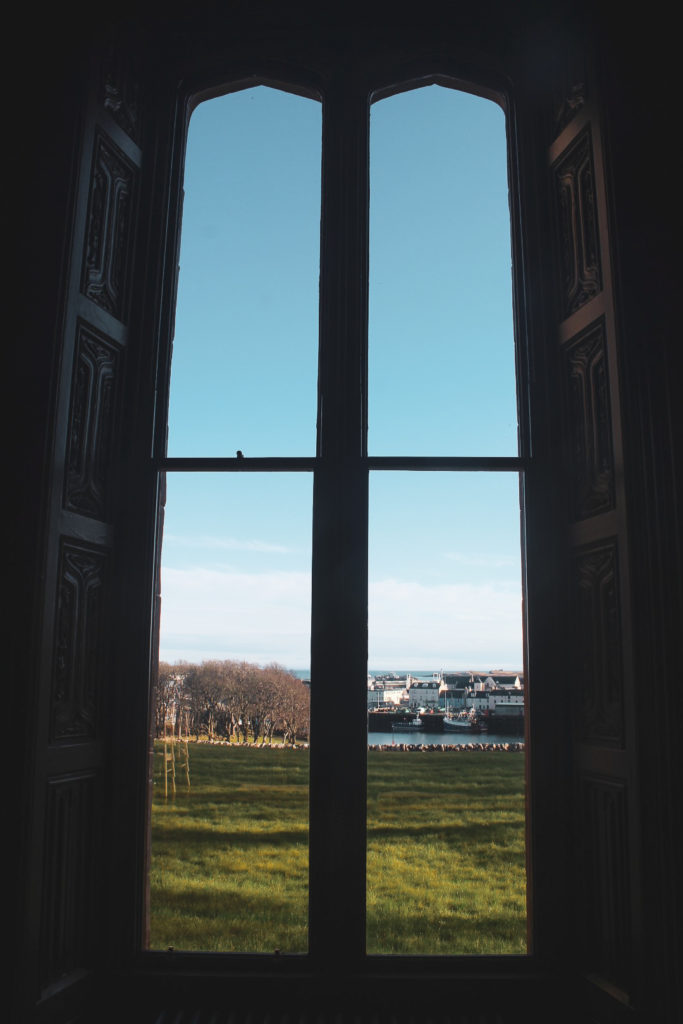
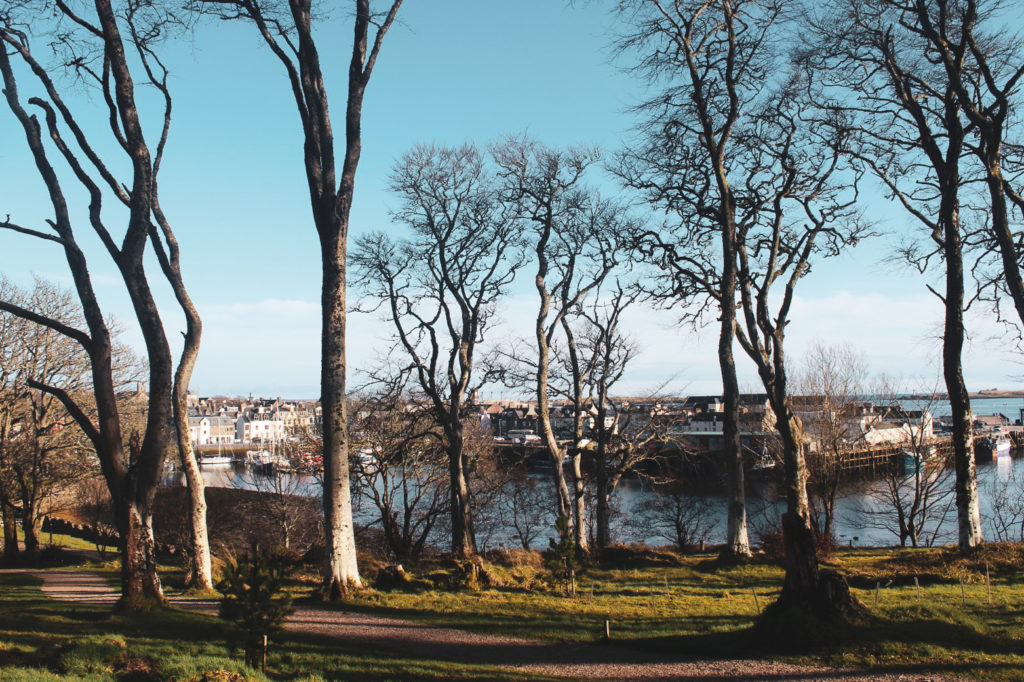

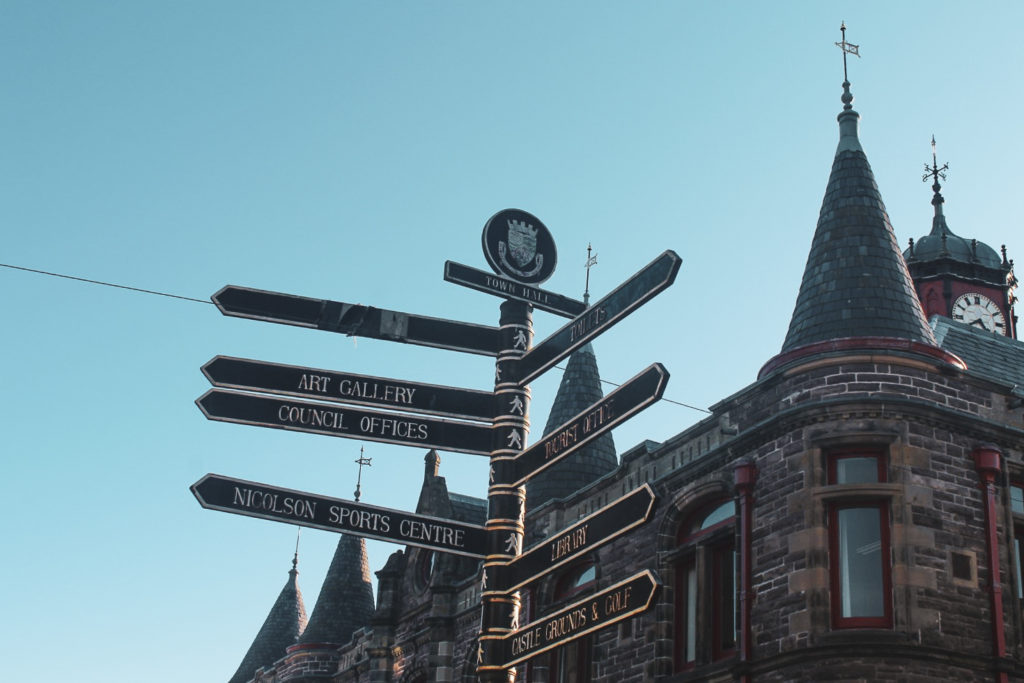

Despite having less time on Lewis and Harris than planned, we made the most of it and saw almost everything we wanted to. The only place we missed out on was the island of Scalpay, where we’d planned to hike to a lighthouse. That will be for the next visit, because Lewis and Harris definitely deserve a revisit – or 10!
Leave a Comment
Pingback: Rocky, rugged and remote: The surprising beauty of the Uists – Northtrotter on 27/02/2021
Pingback: My best travel moments of 2020 – Northtrotter on 27/02/2021
Pingback: My worst travel moments of 2020 – Northtrotter on 27/02/2021
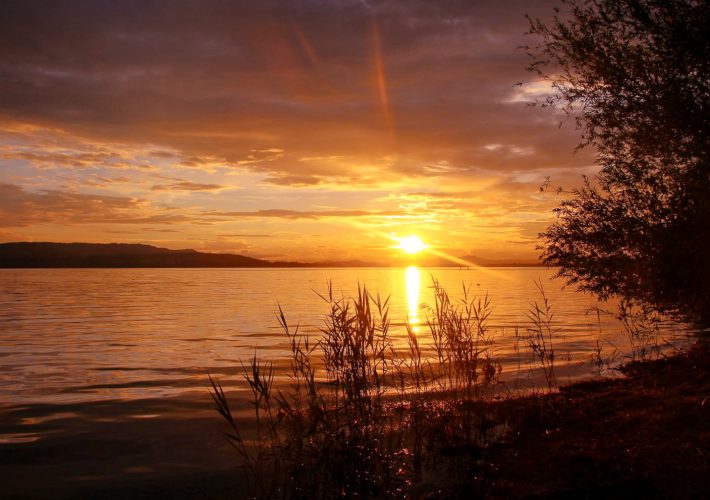

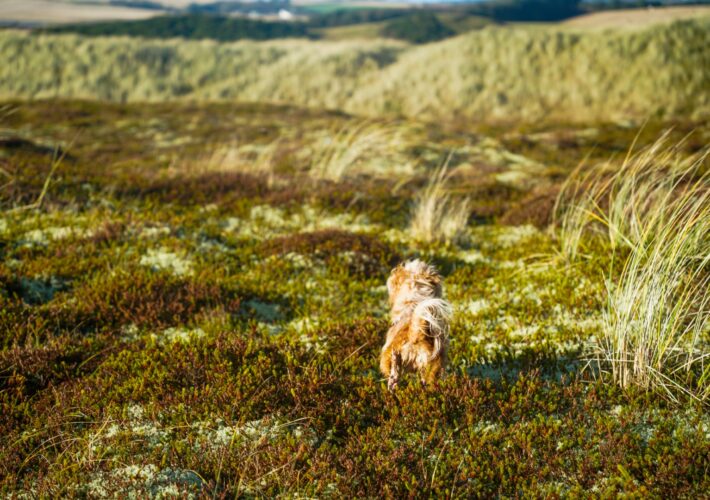

7 COMMENTS
Andrew Briggs
3 years agoI really enjoyed reading your article and seeing the pictures. I was on Harris/Lewis last week, but only for a couple of days. Definitely need to go back for longer. It’s a wonderful place and a photographer’s dream.
Melissa Cherry Villumsen
3 years agoHi Andrew! Thank you so much. Glad you enjoyed my post and the beautiful isles. I agree that the Western Isles deserve sooo much more time. I was also only on Lewis and Harris for two days and I’m dying to return!
Carol Dixon
3 years agoThanks for your pictures and description of two wonderful islands – Harris and Lewis – a lovely reminder of our golden wedding holiday in September last year. We had glorious weather and visited most of the places you did in our caravette including Calanais 1 (which was spectacular) other than the iron age houses and the west coast of Lewis. I was also able to see the crofts on the rugged east coast of Harris along the Golden road where my great grandfather and his ancestors lived. We stayed on the West Highland Trust campervan site overlooking the Atlantic at Nisaboist (between scarista and seilibost beaches south of Luskentyre) with spectacular views towards Taransay and glorious sunsets every night. Thank you for helping me to relive a very special holiday.
Melissa Cherry Villumsen
3 years agoThat sounds like such a wonderful wedding holiday – congrats!! I’m so glad my post helped you relive your special moments!